Paul van Yperen's Blog, page 416
June 14, 2014
Max Landa
Austrian actor Max Landa (1880-1933) with his trademark monocle started his career in silent films opposite Asta Nielsen. Later he starred as the elegant and cosmopolitan gentleman-detective Joe Deebs in the popular silent serial.
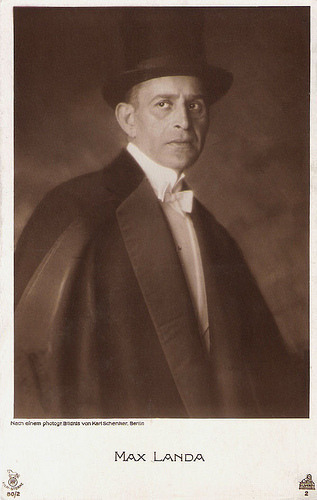
German postcard by Rotophot in the Film Sterne Series, Berlin-Wilm., no. 80/2. Photo: Karl Schenker, Berlin.
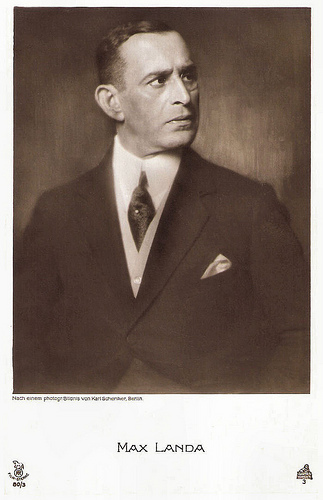
German postcard by Rotophot in the Film Sterne series, no. 80/3. Photo: Olivieri / Karl Schenker.
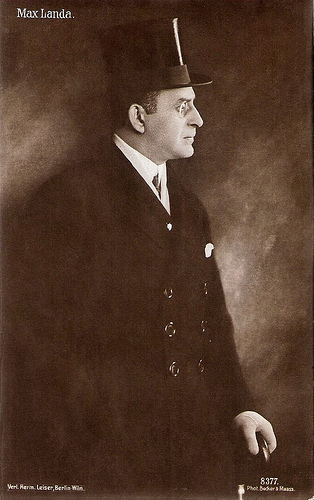
German postcard by Verlag Hermann Leiser, Berlin, no. 8377. Photo: Becker & Maass.
Detective Joe Deebs
Max Landa was born as Max Landau in Vienna, then Austria-Hungary, in 1880 (some sources say in Minsk, Russian Empire in 1873).
He started acting on stage when he was 19, and performed in several theatres in Austria and Germany.
He made his film début film in Die Suffragette/The Suffragette (Urban Gad, 1913) starring Asta Nielsen .
He then played in several films with Nielsen and directed by Urban Gad: Engelein/Little Angel (1913/14), Die weisse Rosen/The White Rose (1914), Das Feuer/The Fire (1914) with Ernst Hofmann , the sequel Engelein’s Hochzeit/Little Angel's Wedding (1916) with Bruno Kastner , Die ewige Nacht/The Eternal Night (1916), and Aschenbrödel/Cinderella (1916).
In 1914 Landa played together with leading man Ernst Reicher in the Stuart Webbs crime serial films Die geheimnisvolle Villa/The Mysterious Villa (Joe May, 1914) and Der Man im Keller/The Man in the Cellar (Joe May, 1914). He then starred in his own serial around the detective character Joe Deebs, from 1915 on.

German postcard by Photochemie, no K. 2298. Photo: Stern-Film. Publicity still for Europa Postlagernd/Europe poste restante (Ewald André Dupont, 1918) with Landa as Joe Deebs.
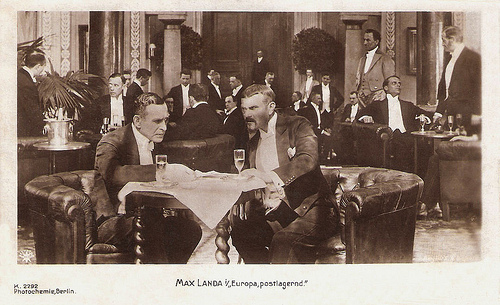
German postcard by Photochemie, no K. 2292. Photo: Stern-Film. Publicity still for Europa Postlagernd/Europe poste restante (Ewald André Dupont, 1918).
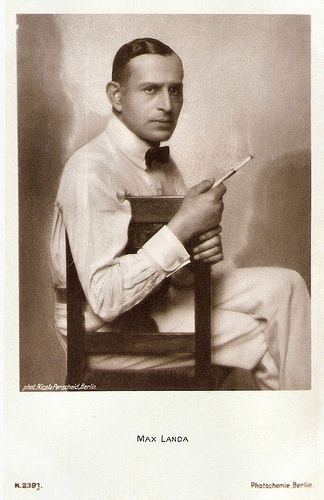
German postcard by Photochemie, Berlin, no. K 2391. Photo: Nicola Perscheid, Berlin.
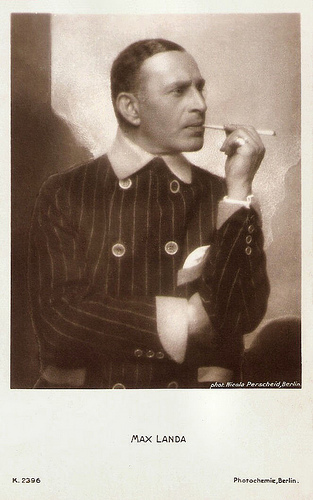
German postcard by Photochemie, Berlin, no. K 2396. Photo: Nicola Perscheid, Berlin.
Antagonistic and Supporting Roles
After the war Max Landa continued to perform as a detective in a succession of crime and adventure films by Ewald André Dupont, produced by Stern-Film: Europa postlagernd/Europe poste restante (1918), Mitternacht/Midnight (1918), Der Teufel/The Devil (1918), Die Japanerin/The Japanese Woman (1919), Das Geheimnis des Amerika-Docks/The Secret of the America Docks (1919), Die Apachen/The Apaches (1919), Die Maske/The Mask (1919), Die Spione/ The Spies (1919), Das Derby/The Derby (1919), Der Würger der Welt/The Strangler of the World (1919), and Das Grand Hotel Babylon/The Grand Hotel Babylon (1919).
Max Landa then played the tragic Rudolf, Crown Prince of Austria in Kaiserin Elisabeth von Österreich/Empress Elisabeth of Austria (Rolf Raffé, 1920).
In 1920 Landa played in a series of crime and detective films with actress Hilde Wörner, who had her own production company.
He also acted once more with Asta Nielsen in Die Geliebte Roswolskys/The Beloved Roswolky's (Felix Basch, 1921), opposite Paul Wegener as Roswolsky.
In 1921 Landa also founded his own Max-Landa Film company for which he produced five films in 1921-1922: Der Passagier von Nr. 7/The passenger of No. 7 (Willy Zeyn, 1921) with Hanni Weisse, Die schwarze Schachdame/The Black Chess Lady (Heinz Herald, 1922), Die Perlen der Lady Harrison/The Pearls of Lady Harrison (Heinz Herald, 1922), Der politische Teppich/The Political Carpet (Heinz Herald, 1922), and Das Licht um Miternacht/The Light at Midnight (Hans von Wolzogen, 1922).
After that, Landa continued to play in German films, but had to satisfy with antagonistic and supporting roles, as in the two-part adventure film Der Flug um den Erdball/The Flight Around the earth (Willi Wolf, 1924) with Ellen Richter, the Manfred Noa society comedies Soll man heiraten?/Should One Marry? (Manfred Noa, 1925) with Vilma Bánky and Warum sich scheiden lassen/Why Divorce? (Manfred Noa, 1926), Die leichte Isabell/Easy Isabell (Eddy Busch, Arthur Wellin, 1927) with Lee Parry and after the operetta by Jean Gilbert, and Anastasia, die falsche Zarentochter/Anastasia, the False Czar's Daughter (Arthur Bergen, 1928) starring Camilla von Hollay .
After 1928 Max Landa quitted playing in film. In 1933, he died in Bled, Yugoslavia (now Slovenia), only 53 years old (or 60 according to some sources).
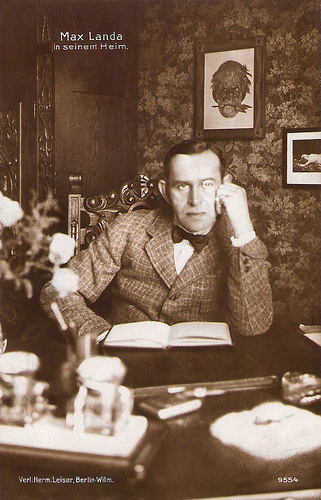
German postcard by Verlag Hermann Leiser, Berlin, no. 9554. Caption: Max Landa in seinem heim (Max Landa at home).
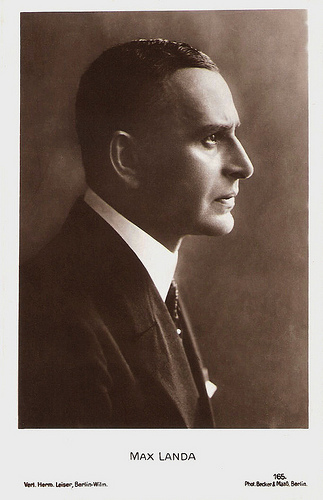
German postcard by Verlag Hermann Leiser, Berlin-Wilm., no. 165. Photo: Becker & Maass, Berlin.
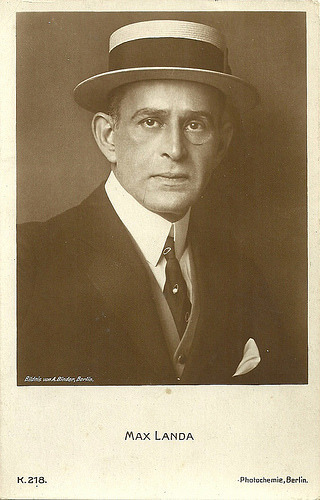
German postcard. Photochemie, Berlin, K. 218. Photo A. Binder, Berlin.
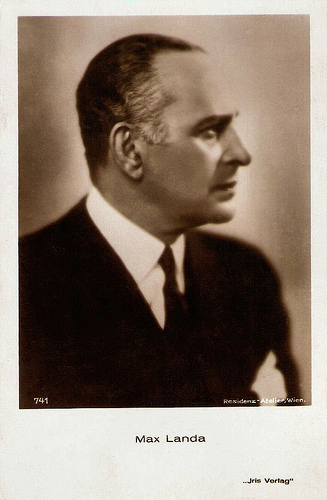
Austrian postcard by Iris Verlag, no. 741. Photo: Residenz-Atelier Wien.
Sources: Thomas Staedeli (Cyranos), Filmportal.de and .

German postcard by Rotophot in the Film Sterne Series, Berlin-Wilm., no. 80/2. Photo: Karl Schenker, Berlin.

German postcard by Rotophot in the Film Sterne series, no. 80/3. Photo: Olivieri / Karl Schenker.

German postcard by Verlag Hermann Leiser, Berlin, no. 8377. Photo: Becker & Maass.
Detective Joe Deebs
Max Landa was born as Max Landau in Vienna, then Austria-Hungary, in 1880 (some sources say in Minsk, Russian Empire in 1873).
He started acting on stage when he was 19, and performed in several theatres in Austria and Germany.
He made his film début film in Die Suffragette/The Suffragette (Urban Gad, 1913) starring Asta Nielsen .
He then played in several films with Nielsen and directed by Urban Gad: Engelein/Little Angel (1913/14), Die weisse Rosen/The White Rose (1914), Das Feuer/The Fire (1914) with Ernst Hofmann , the sequel Engelein’s Hochzeit/Little Angel's Wedding (1916) with Bruno Kastner , Die ewige Nacht/The Eternal Night (1916), and Aschenbrödel/Cinderella (1916).
In 1914 Landa played together with leading man Ernst Reicher in the Stuart Webbs crime serial films Die geheimnisvolle Villa/The Mysterious Villa (Joe May, 1914) and Der Man im Keller/The Man in the Cellar (Joe May, 1914). He then starred in his own serial around the detective character Joe Deebs, from 1915 on.

German postcard by Photochemie, no K. 2298. Photo: Stern-Film. Publicity still for Europa Postlagernd/Europe poste restante (Ewald André Dupont, 1918) with Landa as Joe Deebs.

German postcard by Photochemie, no K. 2292. Photo: Stern-Film. Publicity still for Europa Postlagernd/Europe poste restante (Ewald André Dupont, 1918).

German postcard by Photochemie, Berlin, no. K 2391. Photo: Nicola Perscheid, Berlin.

German postcard by Photochemie, Berlin, no. K 2396. Photo: Nicola Perscheid, Berlin.
Antagonistic and Supporting Roles
After the war Max Landa continued to perform as a detective in a succession of crime and adventure films by Ewald André Dupont, produced by Stern-Film: Europa postlagernd/Europe poste restante (1918), Mitternacht/Midnight (1918), Der Teufel/The Devil (1918), Die Japanerin/The Japanese Woman (1919), Das Geheimnis des Amerika-Docks/The Secret of the America Docks (1919), Die Apachen/The Apaches (1919), Die Maske/The Mask (1919), Die Spione/ The Spies (1919), Das Derby/The Derby (1919), Der Würger der Welt/The Strangler of the World (1919), and Das Grand Hotel Babylon/The Grand Hotel Babylon (1919).
Max Landa then played the tragic Rudolf, Crown Prince of Austria in Kaiserin Elisabeth von Österreich/Empress Elisabeth of Austria (Rolf Raffé, 1920).
In 1920 Landa played in a series of crime and detective films with actress Hilde Wörner, who had her own production company.
He also acted once more with Asta Nielsen in Die Geliebte Roswolskys/The Beloved Roswolky's (Felix Basch, 1921), opposite Paul Wegener as Roswolsky.
In 1921 Landa also founded his own Max-Landa Film company for which he produced five films in 1921-1922: Der Passagier von Nr. 7/The passenger of No. 7 (Willy Zeyn, 1921) with Hanni Weisse, Die schwarze Schachdame/The Black Chess Lady (Heinz Herald, 1922), Die Perlen der Lady Harrison/The Pearls of Lady Harrison (Heinz Herald, 1922), Der politische Teppich/The Political Carpet (Heinz Herald, 1922), and Das Licht um Miternacht/The Light at Midnight (Hans von Wolzogen, 1922).
After that, Landa continued to play in German films, but had to satisfy with antagonistic and supporting roles, as in the two-part adventure film Der Flug um den Erdball/The Flight Around the earth (Willi Wolf, 1924) with Ellen Richter, the Manfred Noa society comedies Soll man heiraten?/Should One Marry? (Manfred Noa, 1925) with Vilma Bánky and Warum sich scheiden lassen/Why Divorce? (Manfred Noa, 1926), Die leichte Isabell/Easy Isabell (Eddy Busch, Arthur Wellin, 1927) with Lee Parry and after the operetta by Jean Gilbert, and Anastasia, die falsche Zarentochter/Anastasia, the False Czar's Daughter (Arthur Bergen, 1928) starring Camilla von Hollay .
After 1928 Max Landa quitted playing in film. In 1933, he died in Bled, Yugoslavia (now Slovenia), only 53 years old (or 60 according to some sources).

German postcard by Verlag Hermann Leiser, Berlin, no. 9554. Caption: Max Landa in seinem heim (Max Landa at home).

German postcard by Verlag Hermann Leiser, Berlin-Wilm., no. 165. Photo: Becker & Maass, Berlin.

German postcard. Photochemie, Berlin, K. 218. Photo A. Binder, Berlin.

Austrian postcard by Iris Verlag, no. 741. Photo: Residenz-Atelier Wien.
Sources: Thomas Staedeli (Cyranos), Filmportal.de and .
Published on June 14, 2014 23:00
June 13, 2014
Michel Piccoli
French actor Michel Piccoli (1925) has appeared in many different roles, from seducer to cop to gangster to Pope in more than 200 films and TV films. Among the directors he worked with are Jean Renoir, Jean-Pierre Melville, Jean-Luc Godard, Agnès Varda, Luis Buñuel, and Alfred Hitchcock.
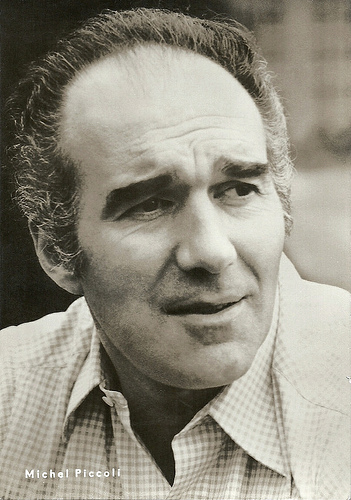
East-German postcard by VEB Progress Filmvertrieb. Collection: Didier Hanson.
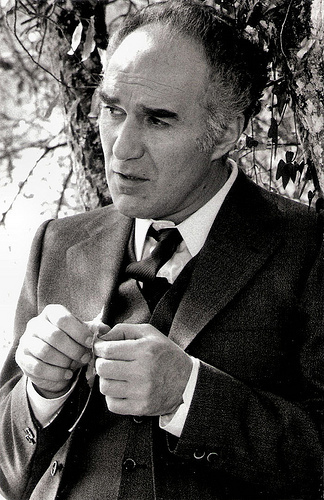
Vintage postcard.
Contempt
Michel Piccoli was born Jacques Daniel Michel Piccoli in Paris in 1925 to a musical family. His French mother Marcelle Piccoli was a pianist and his Italian father Henri Piccoli was a violinist.
At boarding school, the introverted teenager Michel developed a profound love for the stage. He later studied drama under Andrée Bauer-Thérond and then trained as an actor at the René Simon drama school in Paris.
In 1945, he began his stage career with the Renaud-Barrault theatre company at the Théâtre de Babylone in Paris. He made his film debut in Sortilèges (Christian-Jaque, 1945), but his first proper film role was in Le Point du jour/The Mark of the Day (Louis Daquin, 1949).
Piccoli subsequently lent his talents to Jean Renoir in French Cancan (1954) starring Jean Gabin , and René Clair in Les Grandes Manoeuvres/The great manoeuvres (1955) with Gérard Philipe .
It took six more years to become ‘box office’ as a film actor with the gangster film Le Doulos/The Finger Man (Jean-Pierre Melville, 1961), starring Jean-Paul Belmondo .
He then had his international breakthrough with his leading role opposite Brigitte Bardot in Jean-Luc Godard's Le Mépris/Contempt (1963). Hal Erickson at AllMovie : “Like Hollywood's Cary Grant, Jimmy Stewart, and Gary Cooper, Piccoli was possessed of that rare gift of being able to adapt himself to virtually any kind of material without altering his essential screen persona. And like those aforementioned actors, Piccoli's talents suited the prerequisites of a wide variety of directors.”
He worked with some of the best international film auteurs: Agnès Varda at Les Créatures/The Creatures (1966) opposite Catherine Deneuve , Alain Resnais at La Guerre est finie/The War Is Over (1966), Jacques Demy at Les Demoiselles de Rochefort/The Young Girls of Rochefort (1967), and Alfred Hitchcock (Topaz, 1969).
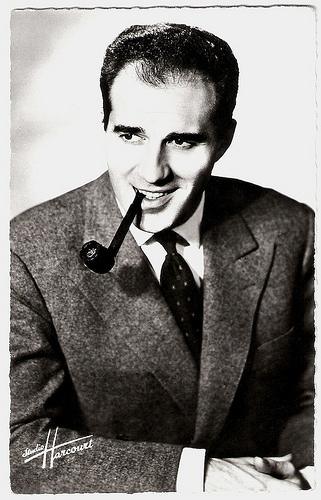
French postcard by Editions du Globe, Paris, no. 795. Photo: Studio Harcourt.
A Symbol of Bourgeois Respectability
Michel Piccoli starred in four of the best-known films of French director Claude Sautet, starting with Choses de la vie/The Little Things in Life (1969) with Romy Schneider . Invariably he was cast as a symbol of bourgeois respectability whose quest for personal fulfilment appears destined to end in failure.
James Travers at French Films.info : “Sautet did more to humanise Piccoli than perhaps any other filmmaker, particularly when the actor was cast alongside Romy Schneider (in Les Choses de la vie and Max et les Ferrailleurs), the actress who became one of Piccoli's dearest friends.”
A darker, more disturbing Piccoli can be seen in the films he made for Luis Buñuel, in particular Le Journal d'une femme de chamber/The Diary of a Chambermaid (1964), Belle de jour/Beauty of the Day (1967) and Le Charme discret de la bourgeoisie/The Discreet Charm of the Bourgeoisie (1972).
Throughout the 1970s and 1980s, Piccoli was one of the most visible faces in the European cinema, with films like Les Noces rouges/Wedding in Blood (Claude Chabrol, 1973), Themroc (Claude Faraldo, 1973), La Grande bouffe/The Big Feast (Marco Ferreri, 1973), Atlantic City (Louis Malle, 1980), and Salto nel vuoto/A Leap in the Dark (Marco Bellocchio, 1980), for which he won the Best Actor Award at the 1980 Cannes Film Festival.
In 1982, he won the Silver Bear at the 32nd Berlin International Film Festival for his chilling role in Une étrange affaire/Strange Affair (Pierre Granmier-Deferre, 1981).
Both as an actor and as a producer Piccoli supported such young filmmakers as Bertrand Tavernier (Des enfants gates/Spoiled Children, 1977), Jacques Doillon (La Fille prodigue/The Prodigal Daughter, 1981) and Leos Carax (Mauvais sang/Bad Blood, 1986).
In 1976, Piccoli recorded his remarkable career on the page when he co-wrote a semi-autobiography, Dialogue Egoistes (Egoist Dialogues). He has been married three times, first to actress Éléonore Hirt (1954-?), then for eleven years to the singer Juliette Gréco (1966-1977) and finally, from 1980 on to writer and actress Ludivine Clerc. He has one daughter from his first marriage, Anne-Cordélia.
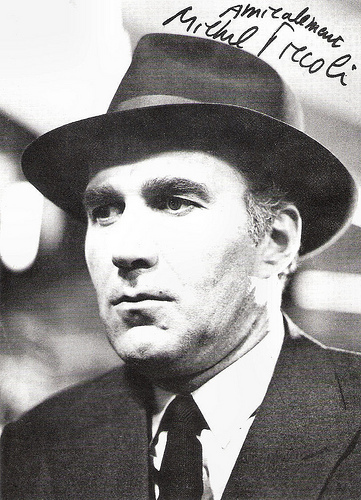 French postcard by La Roue Tourne, Paris.
French postcard by La Roue Tourne, Paris.
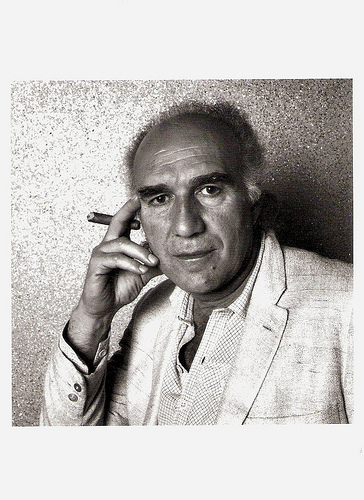
Swiss postcard by Musée de l'Elysée / News Productions, Baulmes, no. 55603. Photo: Laurence Sudre.
Mr. Cinema
In the 1980s, Michel Piccoli resumed his stage career, starring in Peter Brook's acclaimed Paris productions of Anton Tchekhov's The Cherry Orchard (1981, 1983) and Patrice Chéreau's staging of Marivaux's La Fausse Suivante (1985).
He continued to star in films, such as in Milou en mai/Milou in May (Louis Malle, 1990) for which he was nominated for the César. In 1991, Piccoli again won international acclaim for his portrayal of an artist suffering from a creative block in La belle noiseuse (Jacques Rivette, 1991) with Emmanuelle Béart .
Piccoli turned his hand to film directing, starting with a segment for the Amnesty International film Contre l'oubli (1991). His first feature was Alors viola/So There (1997), followed by La Plage noire/The Black Beach (2001) with Dominique Blanc, and C'est pas tout à fait la vie dont j'avais rêvé (2005).
Not surprisingly, he was chosen to impersonate Mr. Cinema in Agnès Varda's Les cent et une nuits de Simon Cinéma/The One Hundred and One Nights of Simon Cinema (1995).
He subsequently continued to do steady work in pictures of varying quality, with highlights being the psychological thriller Généalogies d'une Crime (Raul Ruiz, 1997) with Piccoli as a doctor caught up in a murder mystery, and Je rentre à la maison/ I'm Going Home (Manoel de Oliveira, 2001) with Catherine Deneuve .
In 2001 he was the recipient of the Europe Theatre Prize. In 2002, he supported Lionel Jospin's presidential campaign. Piccoli is vocally opposed to the Front National.
In 2012, he won the David di Donatello (the Italian Oscar) for his role as the pope in the comedy-drama Habemus Papam/We Have a Pope (Nanni Moretti, 2012).
Since then he made again several films. James Travers at French Films.info : “There is something utterly seductive about Piccoli's screen portrayals, which comes from the actor's irresistible personal charm and his ability to project, very subtly, the inner neuroses, desires and venality of his characters. No wonder he is so well-loved by critics and audiences, and so eagerly sought after by filmmakers. Indefatigable, talented and generous, Piccoli deserves his reputation as one of the finest actors of his generation.”
Trailer for Le Mépris/Contempt (1963). Source: The Cult Box (YouTube).
Trailer for Habemus Papam/We Have a Pope (2012). Source: Movieclips Trailers (YouTube).
Sources: James Travers (French Films.info), Hal Erickson (AllMovie), Wikipedia and .

East-German postcard by VEB Progress Filmvertrieb. Collection: Didier Hanson.

Vintage postcard.
Contempt
Michel Piccoli was born Jacques Daniel Michel Piccoli in Paris in 1925 to a musical family. His French mother Marcelle Piccoli was a pianist and his Italian father Henri Piccoli was a violinist.
At boarding school, the introverted teenager Michel developed a profound love for the stage. He later studied drama under Andrée Bauer-Thérond and then trained as an actor at the René Simon drama school in Paris.
In 1945, he began his stage career with the Renaud-Barrault theatre company at the Théâtre de Babylone in Paris. He made his film debut in Sortilèges (Christian-Jaque, 1945), but his first proper film role was in Le Point du jour/The Mark of the Day (Louis Daquin, 1949).
Piccoli subsequently lent his talents to Jean Renoir in French Cancan (1954) starring Jean Gabin , and René Clair in Les Grandes Manoeuvres/The great manoeuvres (1955) with Gérard Philipe .
It took six more years to become ‘box office’ as a film actor with the gangster film Le Doulos/The Finger Man (Jean-Pierre Melville, 1961), starring Jean-Paul Belmondo .
He then had his international breakthrough with his leading role opposite Brigitte Bardot in Jean-Luc Godard's Le Mépris/Contempt (1963). Hal Erickson at AllMovie : “Like Hollywood's Cary Grant, Jimmy Stewart, and Gary Cooper, Piccoli was possessed of that rare gift of being able to adapt himself to virtually any kind of material without altering his essential screen persona. And like those aforementioned actors, Piccoli's talents suited the prerequisites of a wide variety of directors.”
He worked with some of the best international film auteurs: Agnès Varda at Les Créatures/The Creatures (1966) opposite Catherine Deneuve , Alain Resnais at La Guerre est finie/The War Is Over (1966), Jacques Demy at Les Demoiselles de Rochefort/The Young Girls of Rochefort (1967), and Alfred Hitchcock (Topaz, 1969).

French postcard by Editions du Globe, Paris, no. 795. Photo: Studio Harcourt.
A Symbol of Bourgeois Respectability
Michel Piccoli starred in four of the best-known films of French director Claude Sautet, starting with Choses de la vie/The Little Things in Life (1969) with Romy Schneider . Invariably he was cast as a symbol of bourgeois respectability whose quest for personal fulfilment appears destined to end in failure.
James Travers at French Films.info : “Sautet did more to humanise Piccoli than perhaps any other filmmaker, particularly when the actor was cast alongside Romy Schneider (in Les Choses de la vie and Max et les Ferrailleurs), the actress who became one of Piccoli's dearest friends.”
A darker, more disturbing Piccoli can be seen in the films he made for Luis Buñuel, in particular Le Journal d'une femme de chamber/The Diary of a Chambermaid (1964), Belle de jour/Beauty of the Day (1967) and Le Charme discret de la bourgeoisie/The Discreet Charm of the Bourgeoisie (1972).
Throughout the 1970s and 1980s, Piccoli was one of the most visible faces in the European cinema, with films like Les Noces rouges/Wedding in Blood (Claude Chabrol, 1973), Themroc (Claude Faraldo, 1973), La Grande bouffe/The Big Feast (Marco Ferreri, 1973), Atlantic City (Louis Malle, 1980), and Salto nel vuoto/A Leap in the Dark (Marco Bellocchio, 1980), for which he won the Best Actor Award at the 1980 Cannes Film Festival.
In 1982, he won the Silver Bear at the 32nd Berlin International Film Festival for his chilling role in Une étrange affaire/Strange Affair (Pierre Granmier-Deferre, 1981).
Both as an actor and as a producer Piccoli supported such young filmmakers as Bertrand Tavernier (Des enfants gates/Spoiled Children, 1977), Jacques Doillon (La Fille prodigue/The Prodigal Daughter, 1981) and Leos Carax (Mauvais sang/Bad Blood, 1986).
In 1976, Piccoli recorded his remarkable career on the page when he co-wrote a semi-autobiography, Dialogue Egoistes (Egoist Dialogues). He has been married three times, first to actress Éléonore Hirt (1954-?), then for eleven years to the singer Juliette Gréco (1966-1977) and finally, from 1980 on to writer and actress Ludivine Clerc. He has one daughter from his first marriage, Anne-Cordélia.
 French postcard by La Roue Tourne, Paris.
French postcard by La Roue Tourne, Paris. 
Swiss postcard by Musée de l'Elysée / News Productions, Baulmes, no. 55603. Photo: Laurence Sudre.
Mr. Cinema
In the 1980s, Michel Piccoli resumed his stage career, starring in Peter Brook's acclaimed Paris productions of Anton Tchekhov's The Cherry Orchard (1981, 1983) and Patrice Chéreau's staging of Marivaux's La Fausse Suivante (1985).
He continued to star in films, such as in Milou en mai/Milou in May (Louis Malle, 1990) for which he was nominated for the César. In 1991, Piccoli again won international acclaim for his portrayal of an artist suffering from a creative block in La belle noiseuse (Jacques Rivette, 1991) with Emmanuelle Béart .
Piccoli turned his hand to film directing, starting with a segment for the Amnesty International film Contre l'oubli (1991). His first feature was Alors viola/So There (1997), followed by La Plage noire/The Black Beach (2001) with Dominique Blanc, and C'est pas tout à fait la vie dont j'avais rêvé (2005).
Not surprisingly, he was chosen to impersonate Mr. Cinema in Agnès Varda's Les cent et une nuits de Simon Cinéma/The One Hundred and One Nights of Simon Cinema (1995).
He subsequently continued to do steady work in pictures of varying quality, with highlights being the psychological thriller Généalogies d'une Crime (Raul Ruiz, 1997) with Piccoli as a doctor caught up in a murder mystery, and Je rentre à la maison/ I'm Going Home (Manoel de Oliveira, 2001) with Catherine Deneuve .
In 2001 he was the recipient of the Europe Theatre Prize. In 2002, he supported Lionel Jospin's presidential campaign. Piccoli is vocally opposed to the Front National.
In 2012, he won the David di Donatello (the Italian Oscar) for his role as the pope in the comedy-drama Habemus Papam/We Have a Pope (Nanni Moretti, 2012).
Since then he made again several films. James Travers at French Films.info : “There is something utterly seductive about Piccoli's screen portrayals, which comes from the actor's irresistible personal charm and his ability to project, very subtly, the inner neuroses, desires and venality of his characters. No wonder he is so well-loved by critics and audiences, and so eagerly sought after by filmmakers. Indefatigable, talented and generous, Piccoli deserves his reputation as one of the finest actors of his generation.”
Trailer for Le Mépris/Contempt (1963). Source: The Cult Box (YouTube).
Trailer for Habemus Papam/We Have a Pope (2012). Source: Movieclips Trailers (YouTube).
Sources: James Travers (French Films.info), Hal Erickson (AllMovie), Wikipedia and .
Published on June 13, 2014 23:00
June 12, 2014
Hanna Schygulla
German actress and chanson singer Hanna Schygulla (1943) was the icon of the New German Cinema of the 1970s and early 1980s. Schygulla was Rainer Werner Fassbinder's muse and anti-star, and over 12 years, she appeared in 23 of his films. After his death in 1982, she worked together with several other major European directors.
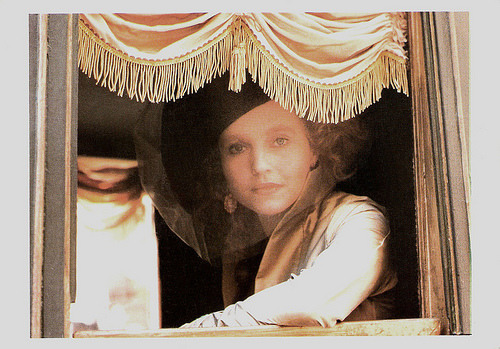
French postcard by Editions La Malibran, Paris, no. MC 21. Photo: publicity still for La Nuit de Varennes (Ettore Scola, 1982).
Love is Colder Than Death
Hanna Schygulla was born in Königshütte in Germany (now Chorzów in Poland), in 1943. Her parents were Antonie (née Mzyk) and Joseph Schygulla, a timber merchant by profession. Her father was drafted as an infantryman in the German Army and was captured by American forces in Italy, subsequently being held as a prisoner of war until 1948. In 1945, Schygulla, and her mother, arrived as refugees in Munich following the expulsion of the majority German population of Königshütte by Communist Poland.
In the 1960s, Schygulla studied Roman languages and German studies, while taking acting lessons in Munich during her spare time. She met Rainer Werner Fassbinder in 1965 and became a member of his collective theatre troupe, Munich Action Theatre.
This group eventually evolved into Fassbinder’s film group, and Schygulla played the female lead in his first feature film Liebe ist kälter als der Tod/Love is Colder Than Death (Rainer Werner Fassbinder, 1969). The reception was generally negative, and the film was even booed at the 19th Berlin International Film Festival in 1969. Today, it is seen as a fine example of Fassbinder's early style, with a heavy 'Nouvelle Vague' influence. The cast as an ensemble won an award at the German Film Awards in 1970.
She was again the lead actress in Katzelmacher (Rainer Werner Fassbinder, 1969). The film centers on an aimless group of friends whose lives are shaken up by the arrival of an immigrant Greek worker, Jorgos (played by Fassbinder himself, in an uncredited role).
Other early Fassbinder films in which she starred were Götter der Pest/Gods of the Plague (Rainer Werner Fassbinder, 1970) with Margaretha von Trotta and Harry Baer, Rio das Mortes (Rainer Werner Fassbinder, 1971), and the Western Whity (Rainer Werner Fassbinder, 1971) with Günther Kaufmann.
The filming of Whity in Spain inspired the Semi-autobiographical drama Warnung vor einer heiligen Nutte/Beware of a Holy Whore (Rainer Werner Fassbinder, 1971) featuring Lou Castel, Eddie Constantine, Schygulla and Fassbinder himself. Holed up in a hotel with too much drink, drugs and time, the cast and crew of a film are gradually disintegrating as they await the arrival of their director.
Very interesting was also Händler der vier Jahreszeiten/The Merchant of Four Seasons (Rainer Werner Fassbinder, 1971) featuring Hans Hirschmueller as a fruit-peddler in 1950s West Germany, who is driven over the edge by an uncaring society.
The following year Schygulla played the object of obsession for fashion designer Petra von Kant (Margit Carstensen) in Die bitteren Tränen der Petra von Kant/The Bitter Tears of Petra von Kant (Rainer Werner Fassbinder, 1972).
During the making of Effi Briest (1974), an adaptation of a German novel by Theodor Fontane, Fassbinder and Schygulla fell out over divergent interpretations of the character. Another problem for Schygulla was the low pay, and she led a revolt against Fassbinder on this issue during production in 1972. Fassbinder's response was typically blunt: "I can't stand the sight of your face any more. You bust my balls".
After the clash, she did not work with him again for five years.
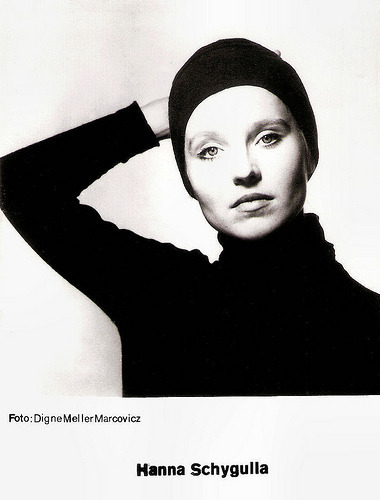
German card. Photo: Digne Meijer Marcovicz.
The Marriage of Maria Braun
Hanna Schygulla started to work with other film makers. She played the female lead in Falsche Bewegung/The Wrong Move (1975), a road movie directed by one of the other major directors of the New German Cinema, Wim Wenders.
In 1978, she reunited with Fassbinder for one of their greatest successes Die Ehe der Maria Braun/The Marriage of Maria Braun (Rainer Werner Fassbinder, 1979). Schygulla starred as Maria, whose marriage to the soldier Hermann remained unfulfilled due to World War II and his post-war imprisonment. Maria adapts to the realities of post-war Germany and becomes the wealthy mistress of an industrialist, all the while staying true to her love for Hermann.
Critic Derek Malcolm called it in The Guardian ‘a landmark in German cinema’: “Schygulla gives a magnificent performance as a vulnerable young woman who becomes a self-confident, independent and competent survivor yet still comes to a bad end, largely because of the basic corruption of her world”. The film was entered into the 29th Berlin International Film Festival, where Schygulla won the Silver Bear for Best Actress for her performance.
She also appeared opposite Günter Lamprecht in the 14-part television miniseries Berlin Alexanderplatz (1980), adapted and directed by Rainer Werner Fassbinder from the Alfred Döblin novel of the same name.
Another success was Lili Marleen (Rainer Werner Fassbinder, 1981), based on the autobiographical novel Der Himmel hat viele Farben (Heaven Has Many Colors) by singer Lale Andersen. The film tells about the forbidden love between the German singer Willie (Schygulla) and the Swiss Jewish composer Robert Mendelssohn (a character based on Rolf Liebermann and played by Giancarlo Giannini), who actively seeks to help an underground group of German Jews during the Third Reich. It was to be her last film with Fassbinder, who died in 1982 at the age of 37.
In the following decade, Schygulla acted in French, Italian and American productions. Among her best known films are La Nuit de Varennes/That Night in Varennes (Ettore Scola, 1982), Passion (Jean-Luc Godard, 1982) with Isabelle Huppert, Storia di Piera/The Story of Piera (Marco Ferreri, 1983) with Huppert and Marcello Mastroianni , Eine Liebe in Deutschland/A Love in Germany (Andrzej Wajda, 1983), and the psychological thriller Dead Again (Kenneth Branagh, 1990) starring Branagh and Emma Thompson.
In the 1990s Schygulla also became known and well regarded as a chanson singer. In Juliane Lorenz's documentary film Life, Love and Celluloid (1998), on Fassbinder and related topics, Schygulla performs several songs.
She also continued to make interesting films, like Werckmeister Harmóniák/Werckmeister Harmonies (Bela Tarr, 2000) and Auf der anderen Seite/The Edge of Heaven (Fatih Akın, 2007). In 2010, she received the Honorary Golden Bear from the Berlin Film Festival.
A year later she played in the Russian film Faust (Alexander Sokurov, 2011), a free interpretation of the Faust legend and its literary adaptations by Johann Wolfgang von Goethe and Thomas Mann. The film won the Golden Lion at the 68th Venice International Film Festival.
At the end of 2013, she published her autobiography, Wach auf und trauma, to mark her 70th birthday. Hanna Schygulla who lived in Paris since 1981, returned to Berlin in 2014.
Trailer Die Ehe der Maria Braun/The Marriage of Maria Braun (Rainer Werner Fassbinder, 1979). Source: UniverseFlick· (YouTube).
Scenes from Lili Marleen (Rainer Werner Fassbinder, 1981). Source: Meloclips (YouTube).
Sources: Derek Malcolm (The Guardian), (IMDb), AllMovie, Deutschland.de, Wikipedia, and .

French postcard by Editions La Malibran, Paris, no. MC 21. Photo: publicity still for La Nuit de Varennes (Ettore Scola, 1982).
Love is Colder Than Death
Hanna Schygulla was born in Königshütte in Germany (now Chorzów in Poland), in 1943. Her parents were Antonie (née Mzyk) and Joseph Schygulla, a timber merchant by profession. Her father was drafted as an infantryman in the German Army and was captured by American forces in Italy, subsequently being held as a prisoner of war until 1948. In 1945, Schygulla, and her mother, arrived as refugees in Munich following the expulsion of the majority German population of Königshütte by Communist Poland.
In the 1960s, Schygulla studied Roman languages and German studies, while taking acting lessons in Munich during her spare time. She met Rainer Werner Fassbinder in 1965 and became a member of his collective theatre troupe, Munich Action Theatre.
This group eventually evolved into Fassbinder’s film group, and Schygulla played the female lead in his first feature film Liebe ist kälter als der Tod/Love is Colder Than Death (Rainer Werner Fassbinder, 1969). The reception was generally negative, and the film was even booed at the 19th Berlin International Film Festival in 1969. Today, it is seen as a fine example of Fassbinder's early style, with a heavy 'Nouvelle Vague' influence. The cast as an ensemble won an award at the German Film Awards in 1970.
She was again the lead actress in Katzelmacher (Rainer Werner Fassbinder, 1969). The film centers on an aimless group of friends whose lives are shaken up by the arrival of an immigrant Greek worker, Jorgos (played by Fassbinder himself, in an uncredited role).
Other early Fassbinder films in which she starred were Götter der Pest/Gods of the Plague (Rainer Werner Fassbinder, 1970) with Margaretha von Trotta and Harry Baer, Rio das Mortes (Rainer Werner Fassbinder, 1971), and the Western Whity (Rainer Werner Fassbinder, 1971) with Günther Kaufmann.
The filming of Whity in Spain inspired the Semi-autobiographical drama Warnung vor einer heiligen Nutte/Beware of a Holy Whore (Rainer Werner Fassbinder, 1971) featuring Lou Castel, Eddie Constantine, Schygulla and Fassbinder himself. Holed up in a hotel with too much drink, drugs and time, the cast and crew of a film are gradually disintegrating as they await the arrival of their director.
Very interesting was also Händler der vier Jahreszeiten/The Merchant of Four Seasons (Rainer Werner Fassbinder, 1971) featuring Hans Hirschmueller as a fruit-peddler in 1950s West Germany, who is driven over the edge by an uncaring society.
The following year Schygulla played the object of obsession for fashion designer Petra von Kant (Margit Carstensen) in Die bitteren Tränen der Petra von Kant/The Bitter Tears of Petra von Kant (Rainer Werner Fassbinder, 1972).
During the making of Effi Briest (1974), an adaptation of a German novel by Theodor Fontane, Fassbinder and Schygulla fell out over divergent interpretations of the character. Another problem for Schygulla was the low pay, and she led a revolt against Fassbinder on this issue during production in 1972. Fassbinder's response was typically blunt: "I can't stand the sight of your face any more. You bust my balls".
After the clash, she did not work with him again for five years.

German card. Photo: Digne Meijer Marcovicz.
The Marriage of Maria Braun
Hanna Schygulla started to work with other film makers. She played the female lead in Falsche Bewegung/The Wrong Move (1975), a road movie directed by one of the other major directors of the New German Cinema, Wim Wenders.
In 1978, she reunited with Fassbinder for one of their greatest successes Die Ehe der Maria Braun/The Marriage of Maria Braun (Rainer Werner Fassbinder, 1979). Schygulla starred as Maria, whose marriage to the soldier Hermann remained unfulfilled due to World War II and his post-war imprisonment. Maria adapts to the realities of post-war Germany and becomes the wealthy mistress of an industrialist, all the while staying true to her love for Hermann.
Critic Derek Malcolm called it in The Guardian ‘a landmark in German cinema’: “Schygulla gives a magnificent performance as a vulnerable young woman who becomes a self-confident, independent and competent survivor yet still comes to a bad end, largely because of the basic corruption of her world”. The film was entered into the 29th Berlin International Film Festival, where Schygulla won the Silver Bear for Best Actress for her performance.
She also appeared opposite Günter Lamprecht in the 14-part television miniseries Berlin Alexanderplatz (1980), adapted and directed by Rainer Werner Fassbinder from the Alfred Döblin novel of the same name.
Another success was Lili Marleen (Rainer Werner Fassbinder, 1981), based on the autobiographical novel Der Himmel hat viele Farben (Heaven Has Many Colors) by singer Lale Andersen. The film tells about the forbidden love between the German singer Willie (Schygulla) and the Swiss Jewish composer Robert Mendelssohn (a character based on Rolf Liebermann and played by Giancarlo Giannini), who actively seeks to help an underground group of German Jews during the Third Reich. It was to be her last film with Fassbinder, who died in 1982 at the age of 37.
In the following decade, Schygulla acted in French, Italian and American productions. Among her best known films are La Nuit de Varennes/That Night in Varennes (Ettore Scola, 1982), Passion (Jean-Luc Godard, 1982) with Isabelle Huppert, Storia di Piera/The Story of Piera (Marco Ferreri, 1983) with Huppert and Marcello Mastroianni , Eine Liebe in Deutschland/A Love in Germany (Andrzej Wajda, 1983), and the psychological thriller Dead Again (Kenneth Branagh, 1990) starring Branagh and Emma Thompson.
In the 1990s Schygulla also became known and well regarded as a chanson singer. In Juliane Lorenz's documentary film Life, Love and Celluloid (1998), on Fassbinder and related topics, Schygulla performs several songs.
She also continued to make interesting films, like Werckmeister Harmóniák/Werckmeister Harmonies (Bela Tarr, 2000) and Auf der anderen Seite/The Edge of Heaven (Fatih Akın, 2007). In 2010, she received the Honorary Golden Bear from the Berlin Film Festival.
A year later she played in the Russian film Faust (Alexander Sokurov, 2011), a free interpretation of the Faust legend and its literary adaptations by Johann Wolfgang von Goethe and Thomas Mann. The film won the Golden Lion at the 68th Venice International Film Festival.
At the end of 2013, she published her autobiography, Wach auf und trauma, to mark her 70th birthday. Hanna Schygulla who lived in Paris since 1981, returned to Berlin in 2014.
Trailer Die Ehe der Maria Braun/The Marriage of Maria Braun (Rainer Werner Fassbinder, 1979). Source: UniverseFlick· (YouTube).
Scenes from Lili Marleen (Rainer Werner Fassbinder, 1981). Source: Meloclips (YouTube).
Sources: Derek Malcolm (The Guardian), (IMDb), AllMovie, Deutschland.de, Wikipedia, and .
Published on June 12, 2014 23:00
June 11, 2014
Vivi Gioi
Italian actress Vivi Gioi (1917–1975) first excelled in the 'telefoni bianchi' comedies of the 1930s. During the war and the late 1940s, she starred in dramatic films. Her best known role is that in Giuseppe De Santis' neorealist drama Caccia tragica/Tragic Hunt (1947). In the late 1940s she was also a major stage actress under the direction of Luchino Visconti and others.
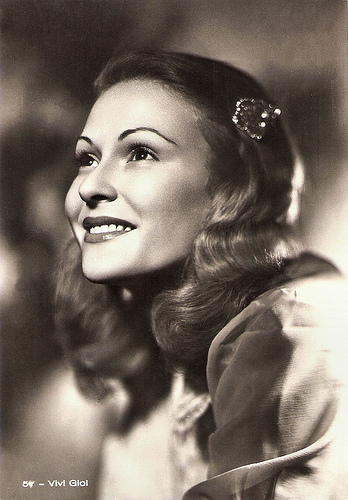
Italian postcard by ASER (A. Scaramaglia Ed. Roma), no. 54. Photo: De Antonis.
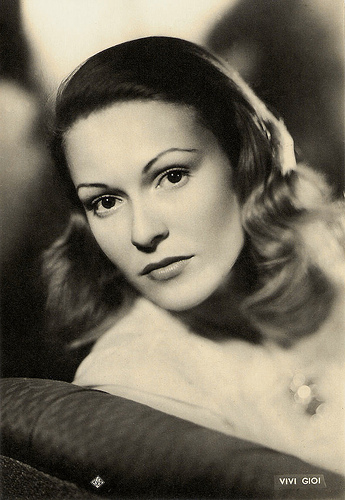
Italian postcard by ASER (A. Scaramaglia Ed. Roma), no. 54 (?). Photo: De Antonis.
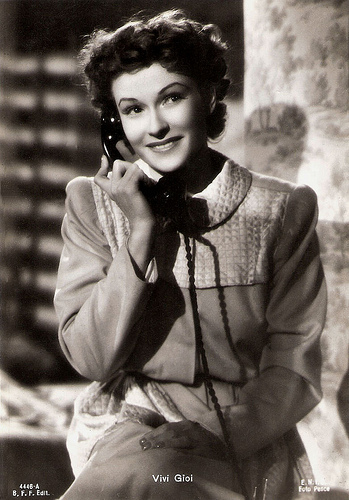
Italian postcard by B.F.F. Edit, no. 4446-A. Photo: Pesce / E.N.I.C.
Surviving at the Casino
Viviana Trumpy was born in Livorno (Leghorn), Italy in 1919. She was Norwegian on her father’s side.
Blond, slim and tall, she carried her fashion model beauty with nonchalance. Vittorio De Sica discovered her during a charity stage show in the late 1930s.
She first transformed in Vivien Diesca, an anagram of De Sica, later on in Vivi Gioi.
Her film debut was in Mario Camerini’s comedy Ma non è una cosa seria/But It's Nothing Serious (1936), after which a small role in De Sica’s Il signor Max/Mister Max (Vittorio De Sica, 1936) followed, of which most was cut out in the editing phase.
When the affair with De Sica stopped and he married Giuditta Ransone, Gioi supposedly quitted filming and survived by playing at the casino.
Her star definitely rose with the lead of Anita in the comedy of misunderstandings Bionda sotto chiave/The Locked In Blond (Camillo Mastrocinque, 1939), scripted by Cesare Zavattini. Gioi played a secretary who suddenly becomes a cover girl.
The role turned her into the Carole Lombard of Italian cinema. Gioi became a star of the telefoni bianchi comedies, such as Rose scarlatte/Red Roses (Vittorio de Sica, 1940).
These light and merry comedies were fit for the celebration of the actress of the moment, and resulted in ever new stars. So competition was fierce, but Vivi soon managed to rise above the average and played in countless comical films in the early 1940s, directed by experienced comedy filmmakers like Max Neufeld, Carlo Ludovico Bragaglia and Dino Falconi.
In Giungla/Jungle (Nunzio Malasomma, 1942) and Bengasi (Augusto Genina, 1942) with Fosco Giachetti , Gioi played her first dramatic roles, with surprising effect. Her career took a new turn.
Often she played foreign characters as in Harlem (Carmine Gallone, 1943). Next to filming, Gioi continued to act on stage and in 1944 she cofounded a theatre company with Nino Besozzi and Vittorio De Sica .
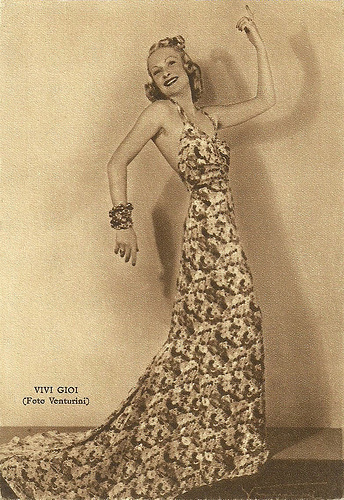
Italian postcard. Photo: Venturini.
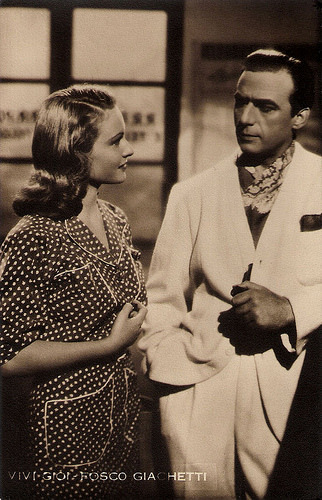
Italian postcard by Agfa. With Fosco Giachetti .
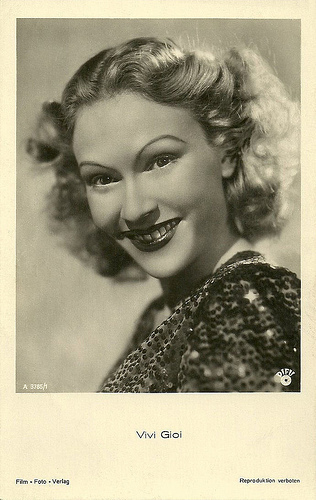
German postcard by Film-Foto-Verlag, no. A 3765/1, 1941-1944. Photo: Difu.
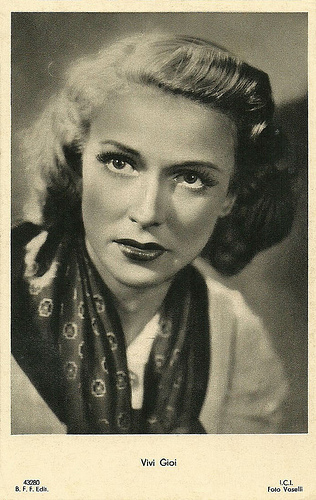
Italian postcard by Ballerini & Fratini (B.F.F. Edit.), Firenze, no. 43280. Photo: ICI / Photo Vaselli.
The Wife of the Dictator
In 1947, Vivi Gioi’s film career reached its peak when she splendidly performed the part of ex-collaborationist Daniela in Caccia tragica/Tragic Hunt (Giuseppe De Santis, 1947).
It won her a Nastro d’Argento as Best Supporting Actress. Despite this award film offers became scarcer, Gioi played less and less in the cinema and focused on the stage, where she worked with such directors as Luchino Visconti and Guido Salvini.
Under Visconti’s direction, Gioi played with Paolo Stoppa and Rina Morelli in A porte chiuse/Huis clos (1945) by Jean-Paul Sartre, with sets by Mario Chiari, and in Il matrimonio di Figaro/Le marriage di Figaro (1946) by Beaumarchais, which co-starred Vittorio De Sica and Nino Besozzi.
In 1948, Gioi played in Come vi piace, Visconti's version of William Shakespeare's As You Like It, with sets and costumes by Salvador Dalí and a year later she played under Visconti’s direction in Tennessee Williams' Un tram che si chiama desiderio/A Streetcar Named Desire, with sets by Franco Zeffirelli, and co-acting by Marcello Mastroianni and Vittorio Gassman .
In 1949 Gioi founded a new company, together with Annibale Ninchi and Aroldo Tieri. In 1950 she played under direction of Guido Salvini in Gli straccioni di Annibal Caro, which co-starred Vittorio Gassman and Massimo Girotti .
Gioi also did radio plays for RAI such as Santa Giovanna (1951) by Thierry Maulnier, again directed by Salvini. With Salvini she also acted in Anna per mille giorni/Anne of a Thousand Days by Maxwell Anderson and in Peer Gynt by Henrik Ibsen.
Only on rare occasions Gioi returned to the set for films like Il processo di Verona/The Verona Trial (Carlo Lizzani, 1963) starring Silvana Mangano . In this drama she played Rachele Mussolini, the wife of the dictator.
In 1975 Vivi Gioi died in Fregene, Italy, hardly 58 years old.
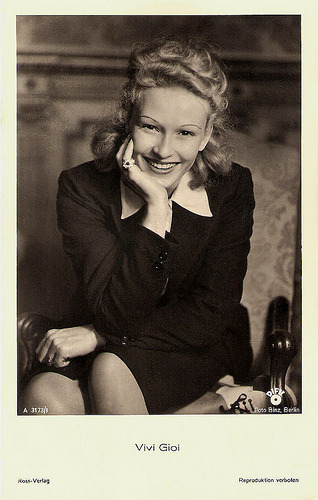
German postcard by Ross-Verlag, no. A 3173/1, 1941-1944. Photo: Binz, Berlin / Difu.
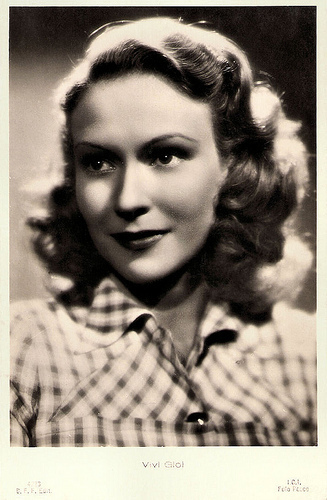
Italian postcard by B.F.F. Edit., no. 4223. Photo: I.C.I. / Pesce.
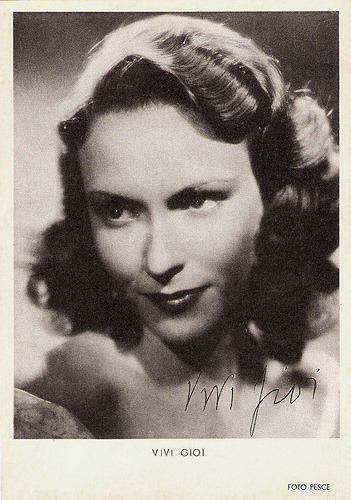
Italian postcard by Forofirma Albore, Milano, no. 1950. Photo: Pesce.
Scene from the film Tutta la città canta/The Whole City is Singing (Riccardo Freda, 1945) with Natalino Otto, Gorni Kramer, Nino Taranto, and i Tre Bonos. Source: AlbertoRabagliati (YouTube).
Sources: Italian Stardust (Italian), My Movies (Italian), Wikipedia (Italian and English), and . NB. Italian Wikipedia has mixed up Gioi’s stage plays, attributing the direction to the set designers of the plays.

Italian postcard by ASER (A. Scaramaglia Ed. Roma), no. 54. Photo: De Antonis.

Italian postcard by ASER (A. Scaramaglia Ed. Roma), no. 54 (?). Photo: De Antonis.

Italian postcard by B.F.F. Edit, no. 4446-A. Photo: Pesce / E.N.I.C.
Surviving at the Casino
Viviana Trumpy was born in Livorno (Leghorn), Italy in 1919. She was Norwegian on her father’s side.
Blond, slim and tall, she carried her fashion model beauty with nonchalance. Vittorio De Sica discovered her during a charity stage show in the late 1930s.
She first transformed in Vivien Diesca, an anagram of De Sica, later on in Vivi Gioi.
Her film debut was in Mario Camerini’s comedy Ma non è una cosa seria/But It's Nothing Serious (1936), after which a small role in De Sica’s Il signor Max/Mister Max (Vittorio De Sica, 1936) followed, of which most was cut out in the editing phase.
When the affair with De Sica stopped and he married Giuditta Ransone, Gioi supposedly quitted filming and survived by playing at the casino.
Her star definitely rose with the lead of Anita in the comedy of misunderstandings Bionda sotto chiave/The Locked In Blond (Camillo Mastrocinque, 1939), scripted by Cesare Zavattini. Gioi played a secretary who suddenly becomes a cover girl.
The role turned her into the Carole Lombard of Italian cinema. Gioi became a star of the telefoni bianchi comedies, such as Rose scarlatte/Red Roses (Vittorio de Sica, 1940).
These light and merry comedies were fit for the celebration of the actress of the moment, and resulted in ever new stars. So competition was fierce, but Vivi soon managed to rise above the average and played in countless comical films in the early 1940s, directed by experienced comedy filmmakers like Max Neufeld, Carlo Ludovico Bragaglia and Dino Falconi.
In Giungla/Jungle (Nunzio Malasomma, 1942) and Bengasi (Augusto Genina, 1942) with Fosco Giachetti , Gioi played her first dramatic roles, with surprising effect. Her career took a new turn.
Often she played foreign characters as in Harlem (Carmine Gallone, 1943). Next to filming, Gioi continued to act on stage and in 1944 she cofounded a theatre company with Nino Besozzi and Vittorio De Sica .

Italian postcard. Photo: Venturini.

Italian postcard by Agfa. With Fosco Giachetti .

German postcard by Film-Foto-Verlag, no. A 3765/1, 1941-1944. Photo: Difu.

Italian postcard by Ballerini & Fratini (B.F.F. Edit.), Firenze, no. 43280. Photo: ICI / Photo Vaselli.
The Wife of the Dictator
In 1947, Vivi Gioi’s film career reached its peak when she splendidly performed the part of ex-collaborationist Daniela in Caccia tragica/Tragic Hunt (Giuseppe De Santis, 1947).
It won her a Nastro d’Argento as Best Supporting Actress. Despite this award film offers became scarcer, Gioi played less and less in the cinema and focused on the stage, where she worked with such directors as Luchino Visconti and Guido Salvini.
Under Visconti’s direction, Gioi played with Paolo Stoppa and Rina Morelli in A porte chiuse/Huis clos (1945) by Jean-Paul Sartre, with sets by Mario Chiari, and in Il matrimonio di Figaro/Le marriage di Figaro (1946) by Beaumarchais, which co-starred Vittorio De Sica and Nino Besozzi.
In 1948, Gioi played in Come vi piace, Visconti's version of William Shakespeare's As You Like It, with sets and costumes by Salvador Dalí and a year later she played under Visconti’s direction in Tennessee Williams' Un tram che si chiama desiderio/A Streetcar Named Desire, with sets by Franco Zeffirelli, and co-acting by Marcello Mastroianni and Vittorio Gassman .
In 1949 Gioi founded a new company, together with Annibale Ninchi and Aroldo Tieri. In 1950 she played under direction of Guido Salvini in Gli straccioni di Annibal Caro, which co-starred Vittorio Gassman and Massimo Girotti .
Gioi also did radio plays for RAI such as Santa Giovanna (1951) by Thierry Maulnier, again directed by Salvini. With Salvini she also acted in Anna per mille giorni/Anne of a Thousand Days by Maxwell Anderson and in Peer Gynt by Henrik Ibsen.
Only on rare occasions Gioi returned to the set for films like Il processo di Verona/The Verona Trial (Carlo Lizzani, 1963) starring Silvana Mangano . In this drama she played Rachele Mussolini, the wife of the dictator.
In 1975 Vivi Gioi died in Fregene, Italy, hardly 58 years old.

German postcard by Ross-Verlag, no. A 3173/1, 1941-1944. Photo: Binz, Berlin / Difu.

Italian postcard by B.F.F. Edit., no. 4223. Photo: I.C.I. / Pesce.

Italian postcard by Forofirma Albore, Milano, no. 1950. Photo: Pesce.
Scene from the film Tutta la città canta/The Whole City is Singing (Riccardo Freda, 1945) with Natalino Otto, Gorni Kramer, Nino Taranto, and i Tre Bonos. Source: AlbertoRabagliati (YouTube).
Sources: Italian Stardust (Italian), My Movies (Italian), Wikipedia (Italian and English), and . NB. Italian Wikipedia has mixed up Gioi’s stage plays, attributing the direction to the set designers of the plays.
Published on June 11, 2014 23:00
June 10, 2014
Sybille Schmitz
Beautiful German actress Sybille Schmitz (1909-1955) started her career in the era of the silent cinema. With her typical face and her relaxed, slightly mysterious way of playing, she became a prominent Ufa star during the Third Reich. After the war she was beset by drug abuse and depression and at 45, she committed suicide.
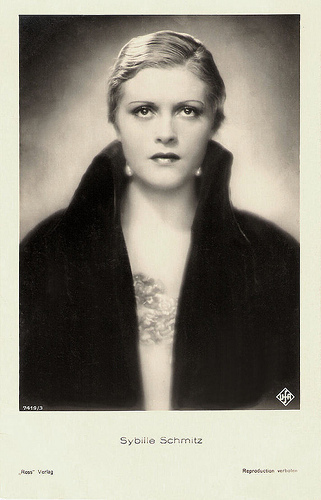
German postcard by Ross Verlag, no. 7419/3, 1932-1933. Photo: Ufa.
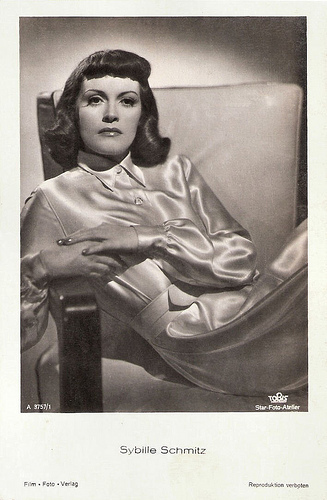
German postcard by Film-Foto-Verlag, no. A 3757/1, 1941-1944. Photo: Star-Foto Atelier / Tobis.
Diary of a Lost Girl
Sybille Maria Christina Schmitz was born in Düren, in the West of Germany, in 1909. She was the daughter of a confectioner.
Schmitz attended an acting school in Köln (Cologne) and got her first engagement at Max Reinhardt's Deutsches Theater in Berlin in 1927. Reinhardt was the most famous stage director of the Weimar republic.
Only one year later, she made her film debut with the SPD party film Freie Fahrt/Free Ride (1928). Her role as a mother who dies of premature birth, attracted her first attention from the critics.
Her other early films include Tagebuch einer Verlorenen/Diary of a Lost Girl (Georg Wilhelm Pabst, 1929) starring Louise Brooks , and Vampyr/Castle of Doom (Carl Theodor Dreyer, 1932) as the haunting beauty Leone. Her beautiful face with the shy look, enormous brooding eyes and sad mouth had a touch of strangeness, loneliness.
In the following years she often played a mysterious and unapproachable woman. She played her first leading role in the SciFi film F.P.1 antwortet nicht/F.P.1 Doesn't Answer (Karl Hartl, 1932) opposite Hans Albers .
Schmitz then established herself as a prominent Ufa star with Der Herr der Welt/Master of the World (Harry Piel, 1934), Abschiedswalzer/Farewell Waltz (Géza von Bolváry, 1934), the Oscar Wilde adaptation Ein idealer Gatte/An Ideal Husband (Herbert Selpin, 1935) with Brigitte Helm , and the horror thriller Fährmann Maria/Death and the Maiden (Frank Wisbar, 1936), in which she played a ferrywoman attempting to save a doomed youth from Death.
Schmitz and the alcoholic director Frank Wisbar lived some years together. Nazi minister of propaganda, Joseph Goebbels, disliked her and thought her 'too foreign'. Schmitz suffered blacklisting by the regime for a while but stage director Gustaf Gründgens persuaded Goebbels to allow her to star in Der Tanz auf dem Vulkan/Dancing on the Volcano (Hans Steinhoff, 1938), one of the many circus melodramas made during the Nazi regime.
She then had roles in Die Frau ohne Vergangenheit/The Mysterious Woman (Nunzio Malasomma, 1939), Trenck, der Pandur (Herbert Selpin, 1940) with Hans Albers , and Titanic (Herbert Selpin, 1943), a technically amazing – for 1943 – film version of the sinking of the British luxury liner in 1912.
According to Hans J. Wollstein at All Movie the film “was promptly banned by Goebbels for being too depressing and not anti-British enough. The drama survives, however, and Schmitz once again offers a standout performance.”
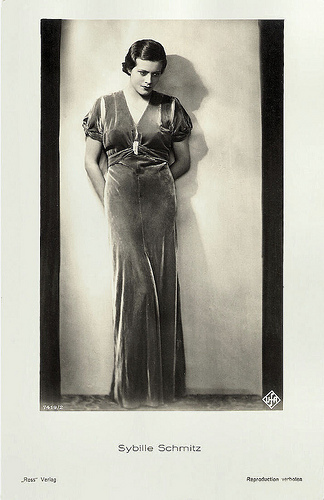
German postcard by Ross Verlag, no. 7419/2, 1932-1933. Photo: Ufa.
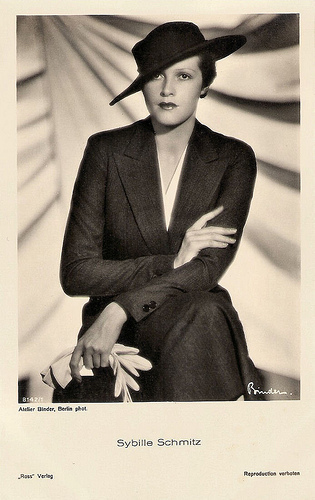
German postcard by Ross Verlag, no. 8142/1, 1933-1934. Photo: Atelier Binder, Berlin.
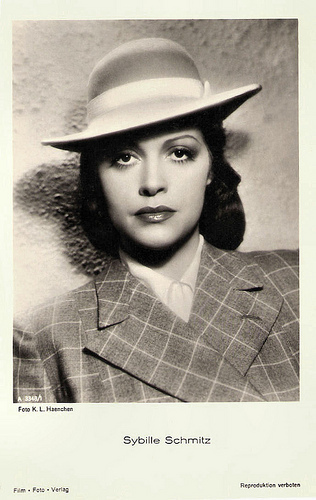
German postcard by Film-Foto-Verlag, no. A 3348/1, 1941-1944. Photo: K.L. Haenchen, Berlin.
Drug Abuse, Depression, Suicide Attempts
After World War II, Sybille Schmitz was shunned by the German film community for continuously working during the Third Reich, and it became difficult for her to land roles.
She appeared in supporting roles in such films as Zwischen gestern und morgen/Between Yesterday and Tomorrow (Harald Braun, 1947) starring Hildegard Knef , Sensation im Savoy (Eduard von Borsody, 1950), and Illusion in Moll/Illusion in a Minor Key (Rudolf Jugert, 1952), but was beset with drug abuse, depression, several suicide attempts and the committal to a psychiatric clinic.
In 1940 she had married author Harald G. Petersson who wrote many of her screenplays and later would write the screenplays for the Winnetou films. Schmitz was bisexual and had a relationship with acting teacher Beate von Molo. Petersson could not cope with his wife’s bisexuality and her ever-increasing consumption of alcohol, so they went their separate ways.
Ironically, the last film she made less than two years before taking her own life, Das Haus an der Küste/The House on the Coast (Bosko Kosanovic, 1953 - now considered a lost film), had Sybille's character committing suicide as a last act of desperation. In 1955, Sybille Schmitz took a fatal overdose of sleeping pills in Munich. She was 45 years old. Schmitz left a note, not blaming anyone in particular for her death and stating that she simply grew weary of her life.
One year later, an action was brought against her doctor, Dr. Ursula Moritz, for improper medical treatment.
Sybille Schmitz's tragic final years inspired Rainer Werner Fassbinder to his acclaimed film Die Sehnsucht der Veronika Voss/Veronika Voss (1982) with Rosel Zech as the tragic film star of the title.
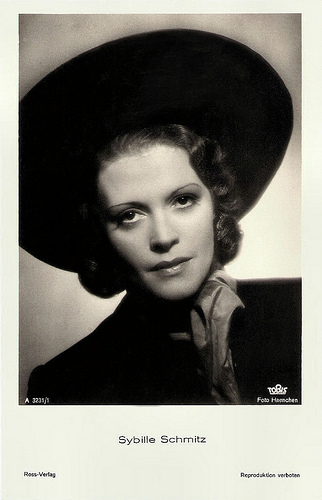
German postcard by Film-Foto-Verlag, nr. A 3231/1, 1941-1944. Photo: K.L. Haenchen, Berlin/Tobis.
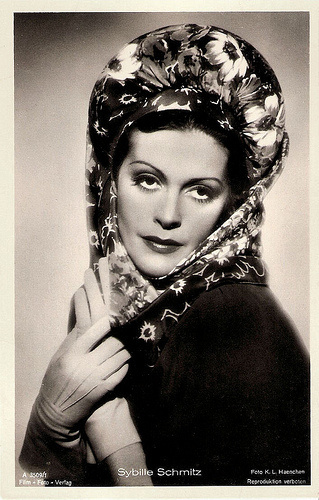
German postcard by Film-Foto-Verlag, no. A 3509/1, 1941-1944. Photo: K.L. Haenchen, Berlin.
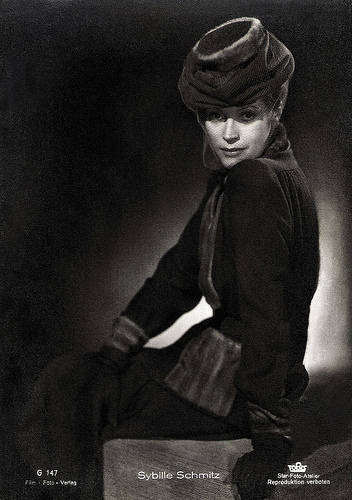
German postcard by Film-Foto-Verlag, no. G 147, 1941-1944. Photo: Star-Foto Atelier / Tobis.
Sources: U. Pothoff (Sybille Schmitz – Die Unbekannte), Hans J. Wollstein (AllMovie), Thomas Staedeli (Cyranos), Wikipedia and .

German postcard by Ross Verlag, no. 7419/3, 1932-1933. Photo: Ufa.

German postcard by Film-Foto-Verlag, no. A 3757/1, 1941-1944. Photo: Star-Foto Atelier / Tobis.
Diary of a Lost Girl
Sybille Maria Christina Schmitz was born in Düren, in the West of Germany, in 1909. She was the daughter of a confectioner.
Schmitz attended an acting school in Köln (Cologne) and got her first engagement at Max Reinhardt's Deutsches Theater in Berlin in 1927. Reinhardt was the most famous stage director of the Weimar republic.
Only one year later, she made her film debut with the SPD party film Freie Fahrt/Free Ride (1928). Her role as a mother who dies of premature birth, attracted her first attention from the critics.
Her other early films include Tagebuch einer Verlorenen/Diary of a Lost Girl (Georg Wilhelm Pabst, 1929) starring Louise Brooks , and Vampyr/Castle of Doom (Carl Theodor Dreyer, 1932) as the haunting beauty Leone. Her beautiful face with the shy look, enormous brooding eyes and sad mouth had a touch of strangeness, loneliness.
In the following years she often played a mysterious and unapproachable woman. She played her first leading role in the SciFi film F.P.1 antwortet nicht/F.P.1 Doesn't Answer (Karl Hartl, 1932) opposite Hans Albers .
Schmitz then established herself as a prominent Ufa star with Der Herr der Welt/Master of the World (Harry Piel, 1934), Abschiedswalzer/Farewell Waltz (Géza von Bolváry, 1934), the Oscar Wilde adaptation Ein idealer Gatte/An Ideal Husband (Herbert Selpin, 1935) with Brigitte Helm , and the horror thriller Fährmann Maria/Death and the Maiden (Frank Wisbar, 1936), in which she played a ferrywoman attempting to save a doomed youth from Death.
Schmitz and the alcoholic director Frank Wisbar lived some years together. Nazi minister of propaganda, Joseph Goebbels, disliked her and thought her 'too foreign'. Schmitz suffered blacklisting by the regime for a while but stage director Gustaf Gründgens persuaded Goebbels to allow her to star in Der Tanz auf dem Vulkan/Dancing on the Volcano (Hans Steinhoff, 1938), one of the many circus melodramas made during the Nazi regime.
She then had roles in Die Frau ohne Vergangenheit/The Mysterious Woman (Nunzio Malasomma, 1939), Trenck, der Pandur (Herbert Selpin, 1940) with Hans Albers , and Titanic (Herbert Selpin, 1943), a technically amazing – for 1943 – film version of the sinking of the British luxury liner in 1912.
According to Hans J. Wollstein at All Movie the film “was promptly banned by Goebbels for being too depressing and not anti-British enough. The drama survives, however, and Schmitz once again offers a standout performance.”

German postcard by Ross Verlag, no. 7419/2, 1932-1933. Photo: Ufa.

German postcard by Ross Verlag, no. 8142/1, 1933-1934. Photo: Atelier Binder, Berlin.

German postcard by Film-Foto-Verlag, no. A 3348/1, 1941-1944. Photo: K.L. Haenchen, Berlin.
Drug Abuse, Depression, Suicide Attempts
After World War II, Sybille Schmitz was shunned by the German film community for continuously working during the Third Reich, and it became difficult for her to land roles.
She appeared in supporting roles in such films as Zwischen gestern und morgen/Between Yesterday and Tomorrow (Harald Braun, 1947) starring Hildegard Knef , Sensation im Savoy (Eduard von Borsody, 1950), and Illusion in Moll/Illusion in a Minor Key (Rudolf Jugert, 1952), but was beset with drug abuse, depression, several suicide attempts and the committal to a psychiatric clinic.
In 1940 she had married author Harald G. Petersson who wrote many of her screenplays and later would write the screenplays for the Winnetou films. Schmitz was bisexual and had a relationship with acting teacher Beate von Molo. Petersson could not cope with his wife’s bisexuality and her ever-increasing consumption of alcohol, so they went their separate ways.
Ironically, the last film she made less than two years before taking her own life, Das Haus an der Küste/The House on the Coast (Bosko Kosanovic, 1953 - now considered a lost film), had Sybille's character committing suicide as a last act of desperation. In 1955, Sybille Schmitz took a fatal overdose of sleeping pills in Munich. She was 45 years old. Schmitz left a note, not blaming anyone in particular for her death and stating that she simply grew weary of her life.
One year later, an action was brought against her doctor, Dr. Ursula Moritz, for improper medical treatment.
Sybille Schmitz's tragic final years inspired Rainer Werner Fassbinder to his acclaimed film Die Sehnsucht der Veronika Voss/Veronika Voss (1982) with Rosel Zech as the tragic film star of the title.

German postcard by Film-Foto-Verlag, nr. A 3231/1, 1941-1944. Photo: K.L. Haenchen, Berlin/Tobis.

German postcard by Film-Foto-Verlag, no. A 3509/1, 1941-1944. Photo: K.L. Haenchen, Berlin.

German postcard by Film-Foto-Verlag, no. G 147, 1941-1944. Photo: Star-Foto Atelier / Tobis.
Sources: U. Pothoff (Sybille Schmitz – Die Unbekannte), Hans J. Wollstein (AllMovie), Thomas Staedeli (Cyranos), Wikipedia and .
Published on June 10, 2014 23:00
June 9, 2014
Walter Müller
Austrian actor Walter Müller (1911-1969) was a popular star of operettas on stage and in the cinema. In the 1940s he appeared as the funny, singing Sonny Boy of many German films and in the early 1950s he often played the friend or competitor of the real hero.
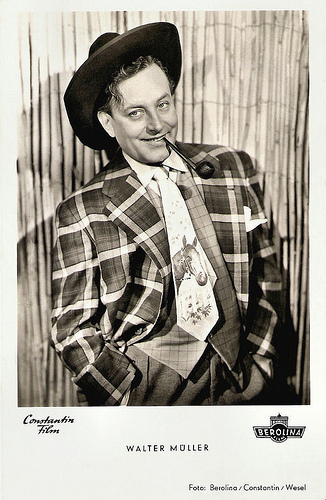
German postcard by Kunst und Bild, Berlin, no. A 1001. Photo: Berolina / Constantin / Wesel. Publicity still for Hurra - ein Junge/Hooray - a boy! (Ernst Marischka, Georg Jacoby, 1953).
Buffo and Operetta Tenor
Walter Müller was born in Prague in Austria-Hungary (now the Czech Republic) in 1911. He was the son of Anton and Theresia Mueller and grew up in Wien (Vienna).
He began his artistic career in 1927 as a chorister at the Landestheater Linz (Linz State Theatre). He then worked in Bodenbach as a Choir pupil and in Bad Hall for the first time as an actor. Mueller had further engagements in Reichenberg (Liberec), Brünn (Brno), Iglau (Jihlava) and Karlsbad (Karlovy Vary).
In Mährisch-Ostrau (Moravia-Ostrava) he performed as a Buffo and operetta tenor. In 1938 he came as a second Bass at the Volksoper in Vienna and sang in such operettas as Frau Luna (Mrs. Luna) and Der Graf von Luxemburg (The Count of Luxembourg).
In 1939 he moved to the Theater am Schiffbauerdamm in Berlin, and from 1940 till the barring of the Berlin theatres in 1944, he was the lead actor of many revues and operettas at the Metropol-Theater.
After the war he played at the Wiener Bürgertheater, where he also directed occasionally.
Since 1938 he also worked extensively for the radio.
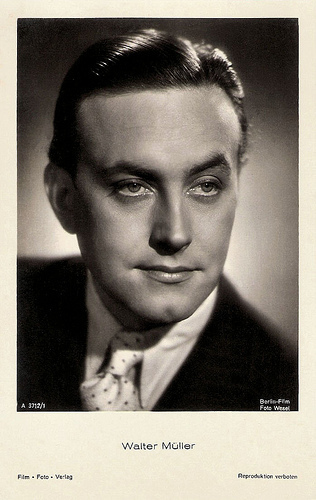
German postcard by Film-Foto-Verlag, no. A 3712/1, 1941-1944. Photo: Berlin-Film / Foto Wesel.
The Funny, Singing Sonny Boy
Walter Müller appeared in the cinema from 1940 on and he always played the funny, singing Sonny Boy.
His film début was in the comedy Herzensfreud – Herzensleid/Heartwarming - Heartaching (Hubert Marischka, 1940) with Paul Klinger .
Very enjoyable is the musical Die Frau meiner Träume/The Woman of My Dreams (Georg Jacoby, 1944) starring Marika Rökk .
During the first half of the 1950s, he was popular in roles as the friend or competitor of the real hero.
His more successful films include the comedy Es schlägt 13/13 O’Clock (E.W. Emo, 1950) with Hans Moser and Theo Lingen , the musical comedy Johannes und die 13 Schönheitsköniginnen/Johannes and the 13 Beauty Queens (Alfred Stöger, 1951) with Sonja Ziemann , and Das Land des Lächelns/Land of Smiles (Hans Deppe, Erik Ode, 1952) starring Márta Eggerth and Jan Kiepura .
He also often played the type of the comic lover, as in Hurra - ein Junge!/Hurray, it’s a boy! (Ernst Marischka, 1953) with Theo Lingen , and Hurra - die Firma hat ein Kind/Hurray, the Firm has a Child (Hans Richter, 1956).
In the early 1960s, his film career was coming to an end. He acted mainly in operetta roles in the theatre again and in 1966 he celebrated his final success in a performance of Maske in Blau (Mask in blue) in the Theater des Westens (theater of the West) at the side of Marika Rökk .
His last film was Spukschloß im Salzkammergut/The Haunted Castle of Salzkammergut (Hans Billian, Rolf Olsen, 1966) starring singer Udo Jürgens .
For some time, he also ran a wine tavern-restaurant in Vienna.
Walter Müller died in 1969 in Starnberg, Germany. Since 1937 he was married to Hedwig Jahnel and they had one daughter.
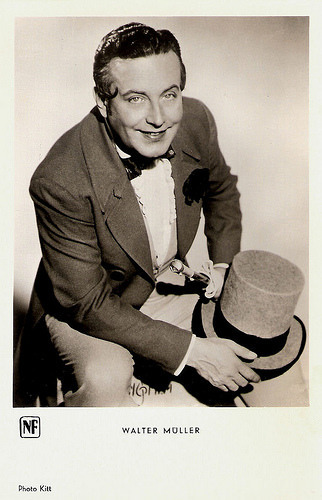
German postcard by Kunst und Bild, Berlin, no. A 788. Photo: Kitt / NF. Publicity still for Einmal keine Sorgen haben/Once have no worries (Georg Marischka, 1953).
Sources: Filmportal.de, Wikipedia (German), and .

German postcard by Kunst und Bild, Berlin, no. A 1001. Photo: Berolina / Constantin / Wesel. Publicity still for Hurra - ein Junge/Hooray - a boy! (Ernst Marischka, Georg Jacoby, 1953).
Buffo and Operetta Tenor
Walter Müller was born in Prague in Austria-Hungary (now the Czech Republic) in 1911. He was the son of Anton and Theresia Mueller and grew up in Wien (Vienna).
He began his artistic career in 1927 as a chorister at the Landestheater Linz (Linz State Theatre). He then worked in Bodenbach as a Choir pupil and in Bad Hall for the first time as an actor. Mueller had further engagements in Reichenberg (Liberec), Brünn (Brno), Iglau (Jihlava) and Karlsbad (Karlovy Vary).
In Mährisch-Ostrau (Moravia-Ostrava) he performed as a Buffo and operetta tenor. In 1938 he came as a second Bass at the Volksoper in Vienna and sang in such operettas as Frau Luna (Mrs. Luna) and Der Graf von Luxemburg (The Count of Luxembourg).
In 1939 he moved to the Theater am Schiffbauerdamm in Berlin, and from 1940 till the barring of the Berlin theatres in 1944, he was the lead actor of many revues and operettas at the Metropol-Theater.
After the war he played at the Wiener Bürgertheater, where he also directed occasionally.
Since 1938 he also worked extensively for the radio.

German postcard by Film-Foto-Verlag, no. A 3712/1, 1941-1944. Photo: Berlin-Film / Foto Wesel.
The Funny, Singing Sonny Boy
Walter Müller appeared in the cinema from 1940 on and he always played the funny, singing Sonny Boy.
His film début was in the comedy Herzensfreud – Herzensleid/Heartwarming - Heartaching (Hubert Marischka, 1940) with Paul Klinger .
Very enjoyable is the musical Die Frau meiner Träume/The Woman of My Dreams (Georg Jacoby, 1944) starring Marika Rökk .
During the first half of the 1950s, he was popular in roles as the friend or competitor of the real hero.
His more successful films include the comedy Es schlägt 13/13 O’Clock (E.W. Emo, 1950) with Hans Moser and Theo Lingen , the musical comedy Johannes und die 13 Schönheitsköniginnen/Johannes and the 13 Beauty Queens (Alfred Stöger, 1951) with Sonja Ziemann , and Das Land des Lächelns/Land of Smiles (Hans Deppe, Erik Ode, 1952) starring Márta Eggerth and Jan Kiepura .
He also often played the type of the comic lover, as in Hurra - ein Junge!/Hurray, it’s a boy! (Ernst Marischka, 1953) with Theo Lingen , and Hurra - die Firma hat ein Kind/Hurray, the Firm has a Child (Hans Richter, 1956).
In the early 1960s, his film career was coming to an end. He acted mainly in operetta roles in the theatre again and in 1966 he celebrated his final success in a performance of Maske in Blau (Mask in blue) in the Theater des Westens (theater of the West) at the side of Marika Rökk .
His last film was Spukschloß im Salzkammergut/The Haunted Castle of Salzkammergut (Hans Billian, Rolf Olsen, 1966) starring singer Udo Jürgens .
For some time, he also ran a wine tavern-restaurant in Vienna.
Walter Müller died in 1969 in Starnberg, Germany. Since 1937 he was married to Hedwig Jahnel and they had one daughter.

German postcard by Kunst und Bild, Berlin, no. A 788. Photo: Kitt / NF. Publicity still for Einmal keine Sorgen haben/Once have no worries (Georg Marischka, 1953).
Sources: Filmportal.de, Wikipedia (German), and .
Published on June 09, 2014 23:00
June 8, 2014
Vít Olmer
Vít Olmer (1942) is a Czech actor, screenwriter, and director. He was the handsome, young hero in many Czechoslovakian films of the 1960s.
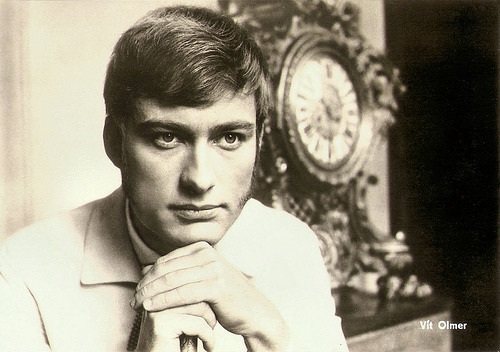
East-German postcard by VEB Progress Filmvertrieb, Berlin, no. 869, 1969. Photo: publicity still for Jarní vody/Spring water (Václav Krska, 1968).
Inquisition
Vít Olmer was born in Prague, Protectorate Bohemia and Moravia (now Czech Republic), in 1942.
As an actor he began in the Most theatre. He made his first film appearance in the lead role of Osení/Green Corn (Václav Krska, 1961).
The following year, he played a big part in the Sci-Fi comedy Muz z prvního století/Man from the first Century (Oldrich Lipsky, 1962).
He had a smaller part in the historical drama Dáblova past/The Devil's Trap (Frantisek Vlácil, 1962) about the inquisition in the 16th Century.
Then he played the lead in the lyrical fairytale Zlaté kapradí/The Golden Fern (Jiri Weiss, 1963) about a shepherd who finds a golden fern with magical powers. The seed of the fern turns into a beautiful young woman (Daniela Smutna) and they fall in love.
The handsome Olmer next starred in the romance Vysoká zed/The High Wall (Karel Kachyna, 1964) with Radka Dulíková.
In 1964 Olmer graduated from the Academy of Performing Arts. The following years, he appeared in such films as the war drama At' zije Republika/Long Live the Republic (Karel Kachyna, 1965), and the comic mystery Fantom Morrisvillu/ The Phantom of Morrisville (Borivoj Zeman, 1966) with Kveta Fialová .
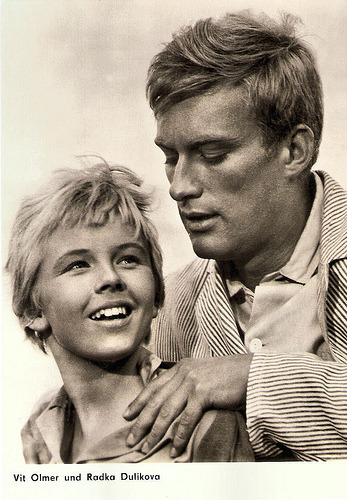
Vit Olmer and Radka Dulíková. East-German postcard by VEB Progress Filmvertrieb, Berlin, no. 2568, 1966. Photo: publicity still for Vysoká zed/The High Wall (Karel Kachyna, 1964).
The Velvet Revolution
In 1966 Vit Olmer studied at the FAMU, the Film and TV School of the Academy of Performing Arts in Prague and started to write and direct his own films.
He would make dozens of films, including the comedy drama Co je vám, doktore?/What’s up doc? (Vit Olmer, 1984), the comedy Jako jed/As Good as Poison (Vit Olmer, 1986) and Bony a klid/The Big Money (Vit Olmer, 1988), a retelling of the Bonnie-and-Clyde legend.
In the same period he continued to star in Czech films by other directors. Among them are the romance Jarní vody/Spring water (Václav Krska, 1968) with Kveta Fialová and the French-Czech coproduction À quelques jours près/A Matter of Days (Yves Ciampi, 1969), which was framed by the student unrest in Prague and Paris during the late 1960s.
He played a German lieutenant in the American war drama The Bridge at Remagen (John Guillermin, 1969), which was partly shot in Czechoslovakia.
At the time of 'normalization' (the velvet revolution of 1989), Vit Olmer was a member of the Communist Party. He does not want to talk about his membership and does not intend to apologize for it.
He continued his film career, mainly as a director.
In 2012 he ran for the Senate as an independent candidate but did not get into the second round.
Vit Olmer is married to actress Simona Chytrová. They have a son, Vitu. From an earlier marriage he has another son, Matěje.
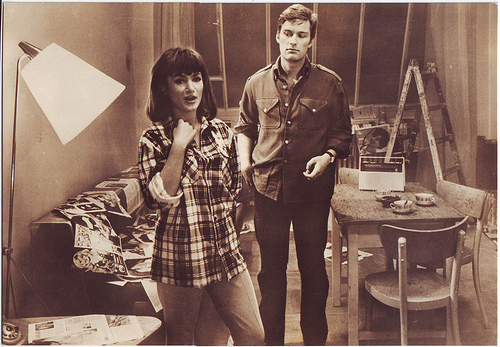
Jana Brejchová and Vit Olmer. East-German postcard by VEB Progress Filmvertrieb, Berlin, no. 2695. Photo: Progress. Collection: Manuel Palomina Arjona / Performing Arts.
Sources: Vojtěch ‘Joeey’ Havlík (Csfd.cz) (Czech), AllMovie, Wikipedia (Czech) and .

East-German postcard by VEB Progress Filmvertrieb, Berlin, no. 869, 1969. Photo: publicity still for Jarní vody/Spring water (Václav Krska, 1968).
Inquisition
Vít Olmer was born in Prague, Protectorate Bohemia and Moravia (now Czech Republic), in 1942.
As an actor he began in the Most theatre. He made his first film appearance in the lead role of Osení/Green Corn (Václav Krska, 1961).
The following year, he played a big part in the Sci-Fi comedy Muz z prvního století/Man from the first Century (Oldrich Lipsky, 1962).
He had a smaller part in the historical drama Dáblova past/The Devil's Trap (Frantisek Vlácil, 1962) about the inquisition in the 16th Century.
Then he played the lead in the lyrical fairytale Zlaté kapradí/The Golden Fern (Jiri Weiss, 1963) about a shepherd who finds a golden fern with magical powers. The seed of the fern turns into a beautiful young woman (Daniela Smutna) and they fall in love.
The handsome Olmer next starred in the romance Vysoká zed/The High Wall (Karel Kachyna, 1964) with Radka Dulíková.
In 1964 Olmer graduated from the Academy of Performing Arts. The following years, he appeared in such films as the war drama At' zije Republika/Long Live the Republic (Karel Kachyna, 1965), and the comic mystery Fantom Morrisvillu/ The Phantom of Morrisville (Borivoj Zeman, 1966) with Kveta Fialová .

Vit Olmer and Radka Dulíková. East-German postcard by VEB Progress Filmvertrieb, Berlin, no. 2568, 1966. Photo: publicity still for Vysoká zed/The High Wall (Karel Kachyna, 1964).
The Velvet Revolution
In 1966 Vit Olmer studied at the FAMU, the Film and TV School of the Academy of Performing Arts in Prague and started to write and direct his own films.
He would make dozens of films, including the comedy drama Co je vám, doktore?/What’s up doc? (Vit Olmer, 1984), the comedy Jako jed/As Good as Poison (Vit Olmer, 1986) and Bony a klid/The Big Money (Vit Olmer, 1988), a retelling of the Bonnie-and-Clyde legend.
In the same period he continued to star in Czech films by other directors. Among them are the romance Jarní vody/Spring water (Václav Krska, 1968) with Kveta Fialová and the French-Czech coproduction À quelques jours près/A Matter of Days (Yves Ciampi, 1969), which was framed by the student unrest in Prague and Paris during the late 1960s.
He played a German lieutenant in the American war drama The Bridge at Remagen (John Guillermin, 1969), which was partly shot in Czechoslovakia.
At the time of 'normalization' (the velvet revolution of 1989), Vit Olmer was a member of the Communist Party. He does not want to talk about his membership and does not intend to apologize for it.
He continued his film career, mainly as a director.
In 2012 he ran for the Senate as an independent candidate but did not get into the second round.
Vit Olmer is married to actress Simona Chytrová. They have a son, Vitu. From an earlier marriage he has another son, Matěje.

Jana Brejchová and Vit Olmer. East-German postcard by VEB Progress Filmvertrieb, Berlin, no. 2695. Photo: Progress. Collection: Manuel Palomina Arjona / Performing Arts.
Sources: Vojtěch ‘Joeey’ Havlík (Csfd.cz) (Czech), AllMovie, Wikipedia (Czech) and .
Published on June 08, 2014 23:00
June 7, 2014
Lisa Weise
German actress Lisa Weise (?-1952) starred in silent films of the 1910s. Most of her films were directed by Friedrich Zelnik and her film partner was often Karl Beckersachs.
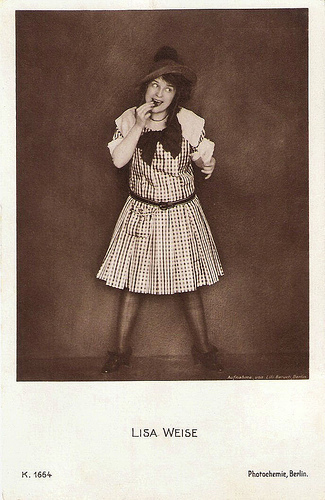
German postcard by Photochemie, Berlin, no. K.1664. Photo: Lili Baruch, Berlin.
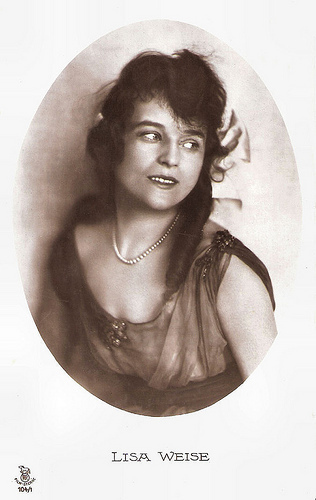
German postcard by Rotophot in the Film-Sterne series, no. 104/1.
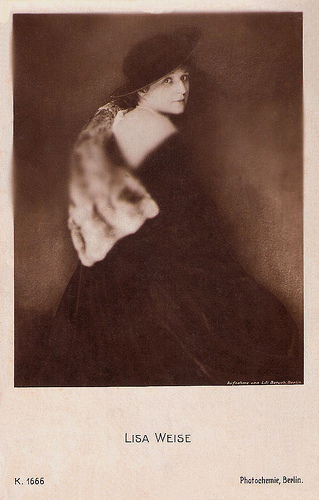
German postcard by Photochemie, Berlin, no. K.1666. Photo: Lili Baruch, Berlin.
Film Magic
Little is known about Lisa Weise. Unknown is for instance when and where she was born.
According to Thomas Staedeli at Cyranos , she made her film debut in Der Graf von Luxemburg/The Count of Luxembourg (1910), but before that she must have worked in the theatre.
She returned to the stage and in 1912 she parodied the silent film in the ‘Posse mit Gesang’ (a kind of popular musical drama) Filmzauber (Film Magic) by Walter Kollo and Willy Bredschneider, with a German libretto by Rudolf Bernauer and Rudolf Schanzer. Her co-star was the celebrated Austrian singer and later film actor, Oscar Sabo.
Filmzauber is a farce, with a number of subplots, centring on the efforts by the idolized silent film producer-actor Adalbert Musenfett to cast himself as Napoleon in a drama set during the Battle of Leipzig. Maria Gesticulata, an Italian tragedienne, is lined up to play his love interest, the pretty Knötteritz tobacco-miller's daughter.
An English version of the farce, The Girl on the Film, translated and adapted by James T. Tanner with additional music by Albert Szirmai, premiered in London in 1913 and was later performed in New York and elsewhere.
In 1915, after an interruption of five years, Weise stood again for the camera and enjoyed a brief film career. Her second film was the silent drama Carl und Carla/Carl and Carla (Carl Wilhelm, 1915), with Karl Beckersachs . Weise starred as both Carl and Carla in this Decla-Bioscop AG production. Her next film was Fräulein Wildfang/Miss Wildfang (1916).
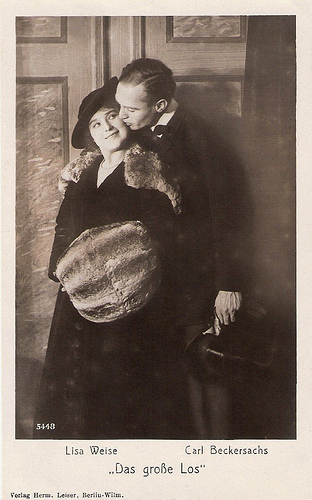
German postcard by Verlag Hermann Leiser, Berlin-Wilm., no. 5448. Photo: publicity still for Das grosse Los/The big prize (Friedrich Zelnik, 1917) with Karl Beckersachs .
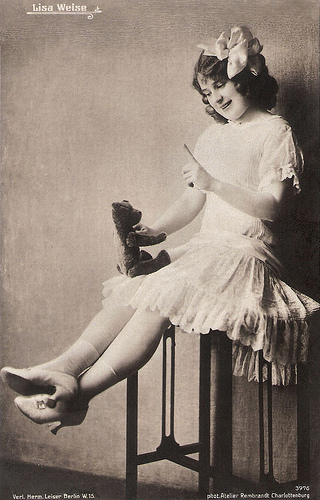
German postcard by Verlag Hermann Leiser, Berlin Wilm., no. 3976. Photo: Rembrandt, Charlottenburg.
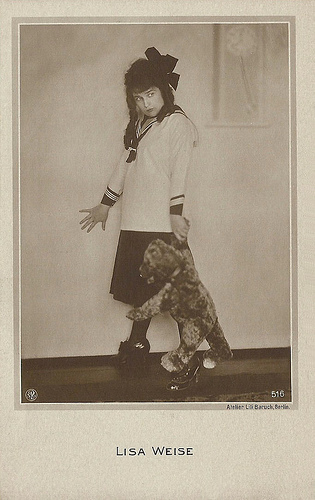
German postcard by NPG, no. 516. Photo: Lili Baruch, Berlin. Collection: Didier Hanson.
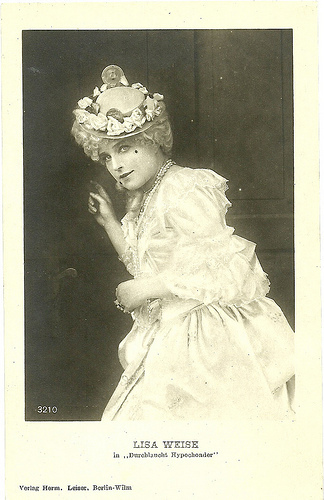
German postcard by Verlag Hermann Leiser, Berlin-Wilm., no. 3210. Photo: publicity still for Durchlaucht Hypochonder/Highness hypochondriac (Friedrich Zelnik, 1918). Collection: Didier Hanson.
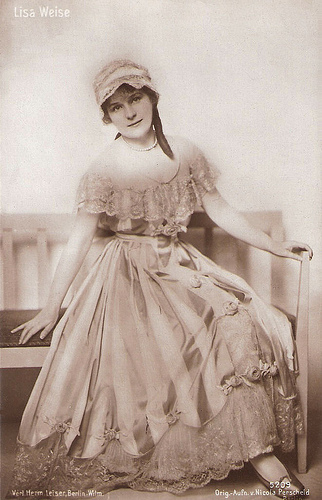
German postcard by Verlag Hermann Leiser, Berlin Wilm., no. 5209. Photo: Nicola Perscheid.
A Circus Girl
Lisa Weise co-starred with Karl Beckersachs again in Ein Zirkusmädel/A circus girl (Carl Wilhelm, 1917).
Producer of the film was Friedrich Zelnik , later known as Frederic Zelnik. Zelnik himself directed Das große Los/The big prize (Friedrich Zelnik, 1917) again with Weise and Beckersachs.
That year Weise also starred in the title role of Klein Doortje/Little Dorrit (Friedrich Zelnik, 1917), an adaptation of Little Dorrit by Charles Dickens. In the cast were also Karl Beckersachs and Grete Weixler.
Furthermore, Lisa Weise made Edelweiß (Friedrich Zelnik, 1917), co-starring with Beckersachs and the future director Lupu Pick.
Lisa Weise made thee more films for the Berliner Film Manufaktur in 1918. The first was Gänseliesel/Liesel of the Geese (Friedrich Zelnik, 1918).
She played the title role in Durchlaucht Hypochonder/Highness hypochondriac (Friedrich Zelnik, 1918) with Karl Beckersachs and Curt Vespermann . The script was written by Ewald André Dupont.
Her final film, according to IMDb was Der Liftjunge/The elevator boy (1918), of which the director is unknown. Staedeli also mentions Amalie - 45 Mark (1918).
After that Lisa Weise retired and he vanished into obscurity. Completely forgotten by the public she died in 1952.
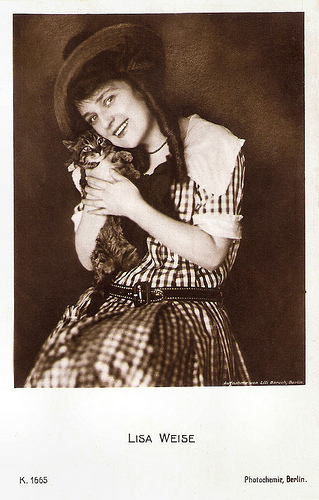
German postcard by Photochemie, Berlin, no. K.1665. Photo: Lili Baruch, Berlin.
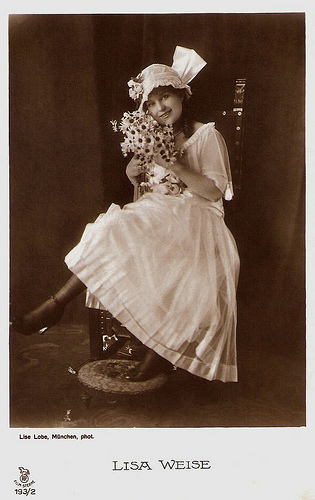
German postcard by Rotophot in the Film Sterne series, no. 193/2. Photo: Lise Lobe, München.
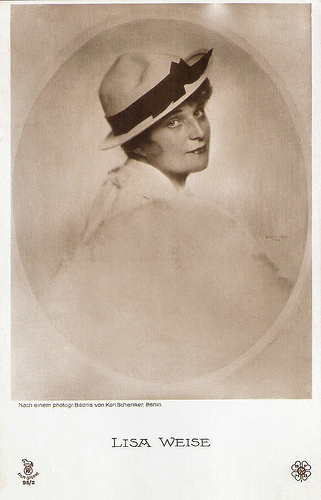
German postcard by Rotophot in the Film-Sterne series, no. 95/2. Photo: Karl Schenker, Berlin / BFWMB.
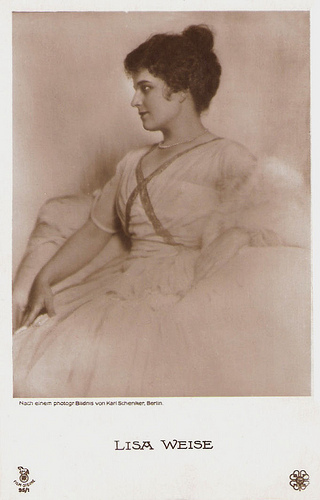
German postcard by Rotophot in the Film Sterne series, no. 95/1. Photo: Karl Schenker, Berlin / NFMB.
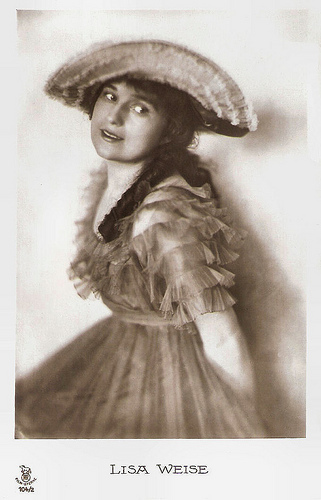
German postcard by Rotophot in the Film-Sterne series, no. 104/2.
Sources: Thomas Staedeli (Cyranos), Wikipedia and .

German postcard by Photochemie, Berlin, no. K.1664. Photo: Lili Baruch, Berlin.

German postcard by Rotophot in the Film-Sterne series, no. 104/1.

German postcard by Photochemie, Berlin, no. K.1666. Photo: Lili Baruch, Berlin.
Film Magic
Little is known about Lisa Weise. Unknown is for instance when and where she was born.
According to Thomas Staedeli at Cyranos , she made her film debut in Der Graf von Luxemburg/The Count of Luxembourg (1910), but before that she must have worked in the theatre.
She returned to the stage and in 1912 she parodied the silent film in the ‘Posse mit Gesang’ (a kind of popular musical drama) Filmzauber (Film Magic) by Walter Kollo and Willy Bredschneider, with a German libretto by Rudolf Bernauer and Rudolf Schanzer. Her co-star was the celebrated Austrian singer and later film actor, Oscar Sabo.
Filmzauber is a farce, with a number of subplots, centring on the efforts by the idolized silent film producer-actor Adalbert Musenfett to cast himself as Napoleon in a drama set during the Battle of Leipzig. Maria Gesticulata, an Italian tragedienne, is lined up to play his love interest, the pretty Knötteritz tobacco-miller's daughter.
An English version of the farce, The Girl on the Film, translated and adapted by James T. Tanner with additional music by Albert Szirmai, premiered in London in 1913 and was later performed in New York and elsewhere.
In 1915, after an interruption of five years, Weise stood again for the camera and enjoyed a brief film career. Her second film was the silent drama Carl und Carla/Carl and Carla (Carl Wilhelm, 1915), with Karl Beckersachs . Weise starred as both Carl and Carla in this Decla-Bioscop AG production. Her next film was Fräulein Wildfang/Miss Wildfang (1916).

German postcard by Verlag Hermann Leiser, Berlin-Wilm., no. 5448. Photo: publicity still for Das grosse Los/The big prize (Friedrich Zelnik, 1917) with Karl Beckersachs .

German postcard by Verlag Hermann Leiser, Berlin Wilm., no. 3976. Photo: Rembrandt, Charlottenburg.

German postcard by NPG, no. 516. Photo: Lili Baruch, Berlin. Collection: Didier Hanson.

German postcard by Verlag Hermann Leiser, Berlin-Wilm., no. 3210. Photo: publicity still for Durchlaucht Hypochonder/Highness hypochondriac (Friedrich Zelnik, 1918). Collection: Didier Hanson.

German postcard by Verlag Hermann Leiser, Berlin Wilm., no. 5209. Photo: Nicola Perscheid.
A Circus Girl
Lisa Weise co-starred with Karl Beckersachs again in Ein Zirkusmädel/A circus girl (Carl Wilhelm, 1917).
Producer of the film was Friedrich Zelnik , later known as Frederic Zelnik. Zelnik himself directed Das große Los/The big prize (Friedrich Zelnik, 1917) again with Weise and Beckersachs.
That year Weise also starred in the title role of Klein Doortje/Little Dorrit (Friedrich Zelnik, 1917), an adaptation of Little Dorrit by Charles Dickens. In the cast were also Karl Beckersachs and Grete Weixler.
Furthermore, Lisa Weise made Edelweiß (Friedrich Zelnik, 1917), co-starring with Beckersachs and the future director Lupu Pick.
Lisa Weise made thee more films for the Berliner Film Manufaktur in 1918. The first was Gänseliesel/Liesel of the Geese (Friedrich Zelnik, 1918).
She played the title role in Durchlaucht Hypochonder/Highness hypochondriac (Friedrich Zelnik, 1918) with Karl Beckersachs and Curt Vespermann . The script was written by Ewald André Dupont.
Her final film, according to IMDb was Der Liftjunge/The elevator boy (1918), of which the director is unknown. Staedeli also mentions Amalie - 45 Mark (1918).
After that Lisa Weise retired and he vanished into obscurity. Completely forgotten by the public she died in 1952.

German postcard by Photochemie, Berlin, no. K.1665. Photo: Lili Baruch, Berlin.

German postcard by Rotophot in the Film Sterne series, no. 193/2. Photo: Lise Lobe, München.

German postcard by Rotophot in the Film-Sterne series, no. 95/2. Photo: Karl Schenker, Berlin / BFWMB.

German postcard by Rotophot in the Film Sterne series, no. 95/1. Photo: Karl Schenker, Berlin / NFMB.

German postcard by Rotophot in the Film-Sterne series, no. 104/2.
Sources: Thomas Staedeli (Cyranos), Wikipedia and .
Published on June 07, 2014 23:00
June 6, 2014
René Cresté
René Cresté (1881-1922) was a French stage and film actor and director of the silent film era. He is best remembered as the amazingly cool title character in the crime-adventure serial Judex (1917-1918), directed by Louis Feuillade. Judex was the first superhero of the cinema.
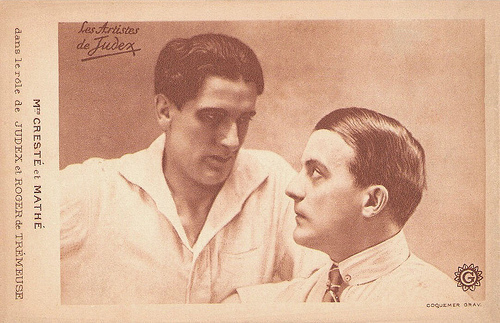
French postcard by Coquemer Gravures, Paris. Photo: Gaumont. Still for La nouvelle mission de Judex (Louis Feuillade, 1917-1918).
Louis Feuillade
René Cresté was born in Paris, France, in 1881.
He began his acting career on the stages of Paris as a jeune premier in plays such as Claudine à Paris (Claudine in Paris) by and with Colette, Ruy Blas by Victor Hugo, and Adrienne Lecouvreur by Eugene Scribe. In 1913, Alphonse Séché engaged him for his Nouveau Théâtre d’Art to play leading roles in several plays.
Cresté was also signed to a contract to the Gaumont Film Company in 1908. Little is known of these first film appearances as they are considered lost. For Pathé he appeared in La chatte métamorphosée en femme/The cat transformed in a woman (Michel Carré, 1910) with Carlos Avril.
In 1912 he began appearing in a series of mystery shorts directed by Léonce Perret for Gaumont. These films included La bonne hôtesse/The good hostess (Léonce Perret, 1912) with Suzanne Grandais , Le mariage de Suzie/Suzie’s Wedding (Léonce Perret, 1912) with Suzanne Grandais , and Par l’amour/By Love (Léonce Perret, 1913) with Jean Aymé.
At the onset of the First World War, Cresté enlisted in the French army and actively participated in the fighting. Injured and demobilized, he resumed his acting career at Gaumont studios by the end of 1915 and appeared in Son or/His Gold (Louis Feuillade, 1915) with Yvette Andréyor , Dernier amour/Last love (Léonce Perret, 1916) with Valentine Petit, and Le roi de la montagne/The King of the Mountain (Léonce Perret, 1916) with Fabienne Fabrèges.
In 1917 he played in several films for Louis Feuillade, including Le passé de Monique/Monique (Louis Feuillade, 1917) with Edouard Mathé , Mon Oncle/My Uncle (Louis Feuillade, 1917) with Musidora , and Les petites marionnettes/The small puppets (Louis Feuillade, 1917) again opposite Edouard Mathé .
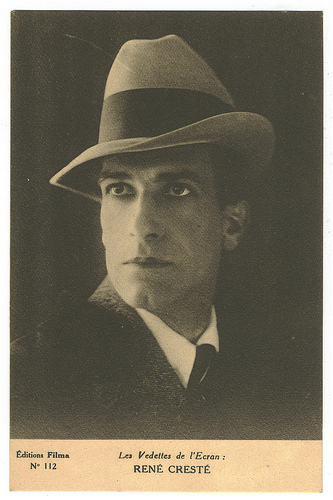
French postcard in the series Les Vedettes de l'Ecran by Editions Film, no. 112. Collection: Performing Arts / Manuel Palormina Ajona.
Le Panthéon du cinéma
René Cresté was then cast for his greatest role – Judex, a positive hero who steals to help the poor. The character's arch-nemesis is the callous banker Favraux, who had carelessly driven thousands of people into bankruptcy.
In 1916, Feuillade and writer Arthur Bernède had begun to develop a surrealistic character called 'Jacques de Tremeuse' (aka Judex) - a mysterious avenger who sports a signature long dark cloak, a wide-brimmed black hat, and a fatalistic air.
Judex (which means Justice) appears and disappears like a ghost, and would appear to have mild hypnotic powers. He is a master of disguise, and an excellent fighter. He commands the loyalty of an organization composed of circus folks and redeemed apaches. Finally, he flies a plane and has a secret lair, where he interrogates his prisoners through a ‘television’ screen - everything Judex writes on the screen on his desk appears on a similar screen on the wall of his victim's cell.
The serial began production in 1917 and was released the same year in its first instalment to critical and public praise. Jefferey M. Anderson at Combustible Celluloid calls Judex an ‘unalloyed masterwork’: “establishing Feuillade as one of history's greatest directors. He had an uncanny knack for finding shocking beauty in simple images, such as a gate or a wall or an antique car driving down the road”.
The character of Judex is widely recognized as one of cinema's first superheroes. René Cresté, who was already popular among female audiences, now became an immensely popular film star.
Judex also starred Musidora as villainess Diana Monti, Édouard Mathé , Gaston Michel, the young René Poyen , and Yvette Andréyor .
Simultaneously with the release of the serial, a novelization, signed by both Feuillade and Bernède, was released, first as a serial in Le Petit Parisien, then in a collected edition by Tallandier.
The following year a sequel was made, La nouvelle mission de Judex/The New Mission of Judex (Louis Feuillade, 1917), which landed Cresté definitively in ‘le Panthéon du cinéma’, as Philippe Pelletier writes so beautifully at Ciné Artistes .
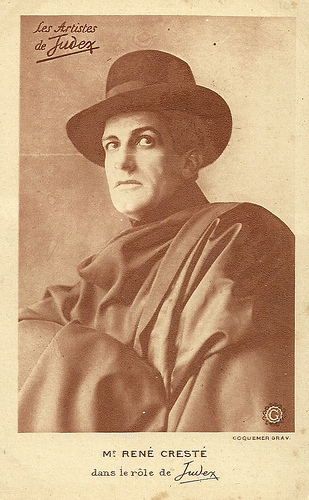
French postcard by Coquemer Gravures. Photo: Gaumont. Still for La nouvelle mission de Judex (1917-1918).
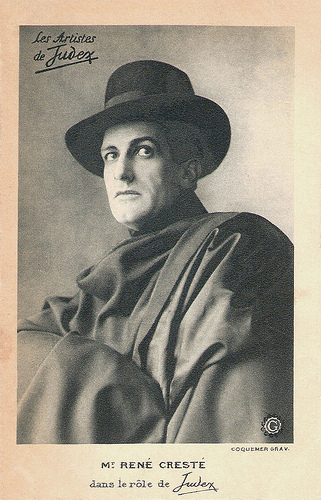
French postcard by Coquemer Gravures. Photo: Gaumont. Still for La nouvelle mission de Judex (1917-1918).
Eyes Without a Face
Following the success of Judex, René Cresté appeared in the serials Tih Minh (Louis Feuillade, 1918), and Vendémiaire (Louis Feuillade, 1918) with Édouard Mathé and Mary Harald. Both were less successful than Judex.
He also appeared in the films L’homme sans visage/Eyes Without a Face (Louis Feuillade, 1919) with Gina Manès , L’engrenage/The gearing (Louis Feuillade, 1919) with Geneviève Félix , and L’énigme/Enigma (Louis Feuillade, 1919) with Fernand Herrmann.
Then Cresté founded his own film production company, Films-René-Cresté, for which he produced and directed Le château du silence/The Silent Castle (René Cresté, 1919) and L’aventure de René/René’s Adventure (René Cresté, 1921).
His last film was Un coup de tête/A Whim (René Cresté, 1922). All his productions were ultimately unsuccessful.
Disappointed and ruined he decided to take the management of an Parisian Cinema, the Cocorico. He also played Judex again at the stage of the Gaîté-Rochechouart.
In 1922, René Cresté died of tuberculosis in Paris, aged 40. To support the financial needs of his widow and infirmed daughter, a charity gala was organized by friends of the Cresté family with the help of the Surrealist artists in February 1929. Three months following the event, his only daughter Renée died.
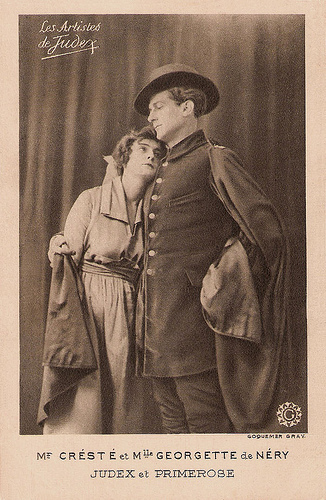
French postcard by Coquemer Gravures. Photo: Production Gaumont. Still for the sequel La nouvelle mission de Judex (1917-1918) with Georgette de Néry .
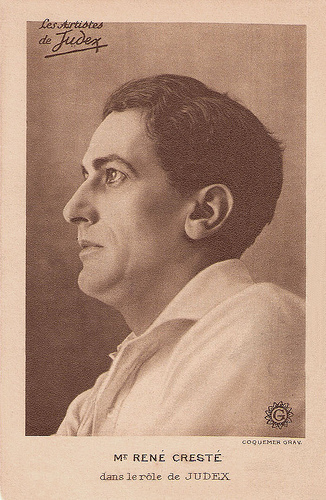
French postcard. Production Gaumont. Coquemer Gravures. Still for La nouvelle mission de Judex (1917-1918).
Sources: Jeffrey M. Anderson (Combustible Celluloid), Philippe Pelletier (CinéArtistes), French Wold Newton Universe, Wikipedia and .

French postcard by Coquemer Gravures, Paris. Photo: Gaumont. Still for La nouvelle mission de Judex (Louis Feuillade, 1917-1918).
Louis Feuillade
René Cresté was born in Paris, France, in 1881.
He began his acting career on the stages of Paris as a jeune premier in plays such as Claudine à Paris (Claudine in Paris) by and with Colette, Ruy Blas by Victor Hugo, and Adrienne Lecouvreur by Eugene Scribe. In 1913, Alphonse Séché engaged him for his Nouveau Théâtre d’Art to play leading roles in several plays.
Cresté was also signed to a contract to the Gaumont Film Company in 1908. Little is known of these first film appearances as they are considered lost. For Pathé he appeared in La chatte métamorphosée en femme/The cat transformed in a woman (Michel Carré, 1910) with Carlos Avril.
In 1912 he began appearing in a series of mystery shorts directed by Léonce Perret for Gaumont. These films included La bonne hôtesse/The good hostess (Léonce Perret, 1912) with Suzanne Grandais , Le mariage de Suzie/Suzie’s Wedding (Léonce Perret, 1912) with Suzanne Grandais , and Par l’amour/By Love (Léonce Perret, 1913) with Jean Aymé.
At the onset of the First World War, Cresté enlisted in the French army and actively participated in the fighting. Injured and demobilized, he resumed his acting career at Gaumont studios by the end of 1915 and appeared in Son or/His Gold (Louis Feuillade, 1915) with Yvette Andréyor , Dernier amour/Last love (Léonce Perret, 1916) with Valentine Petit, and Le roi de la montagne/The King of the Mountain (Léonce Perret, 1916) with Fabienne Fabrèges.
In 1917 he played in several films for Louis Feuillade, including Le passé de Monique/Monique (Louis Feuillade, 1917) with Edouard Mathé , Mon Oncle/My Uncle (Louis Feuillade, 1917) with Musidora , and Les petites marionnettes/The small puppets (Louis Feuillade, 1917) again opposite Edouard Mathé .

French postcard in the series Les Vedettes de l'Ecran by Editions Film, no. 112. Collection: Performing Arts / Manuel Palormina Ajona.
Le Panthéon du cinéma
René Cresté was then cast for his greatest role – Judex, a positive hero who steals to help the poor. The character's arch-nemesis is the callous banker Favraux, who had carelessly driven thousands of people into bankruptcy.
In 1916, Feuillade and writer Arthur Bernède had begun to develop a surrealistic character called 'Jacques de Tremeuse' (aka Judex) - a mysterious avenger who sports a signature long dark cloak, a wide-brimmed black hat, and a fatalistic air.
Judex (which means Justice) appears and disappears like a ghost, and would appear to have mild hypnotic powers. He is a master of disguise, and an excellent fighter. He commands the loyalty of an organization composed of circus folks and redeemed apaches. Finally, he flies a plane and has a secret lair, where he interrogates his prisoners through a ‘television’ screen - everything Judex writes on the screen on his desk appears on a similar screen on the wall of his victim's cell.
The serial began production in 1917 and was released the same year in its first instalment to critical and public praise. Jefferey M. Anderson at Combustible Celluloid calls Judex an ‘unalloyed masterwork’: “establishing Feuillade as one of history's greatest directors. He had an uncanny knack for finding shocking beauty in simple images, such as a gate or a wall or an antique car driving down the road”.
The character of Judex is widely recognized as one of cinema's first superheroes. René Cresté, who was already popular among female audiences, now became an immensely popular film star.
Judex also starred Musidora as villainess Diana Monti, Édouard Mathé , Gaston Michel, the young René Poyen , and Yvette Andréyor .
Simultaneously with the release of the serial, a novelization, signed by both Feuillade and Bernède, was released, first as a serial in Le Petit Parisien, then in a collected edition by Tallandier.
The following year a sequel was made, La nouvelle mission de Judex/The New Mission of Judex (Louis Feuillade, 1917), which landed Cresté definitively in ‘le Panthéon du cinéma’, as Philippe Pelletier writes so beautifully at Ciné Artistes .

French postcard by Coquemer Gravures. Photo: Gaumont. Still for La nouvelle mission de Judex (1917-1918).

French postcard by Coquemer Gravures. Photo: Gaumont. Still for La nouvelle mission de Judex (1917-1918).
Eyes Without a Face
Following the success of Judex, René Cresté appeared in the serials Tih Minh (Louis Feuillade, 1918), and Vendémiaire (Louis Feuillade, 1918) with Édouard Mathé and Mary Harald. Both were less successful than Judex.
He also appeared in the films L’homme sans visage/Eyes Without a Face (Louis Feuillade, 1919) with Gina Manès , L’engrenage/The gearing (Louis Feuillade, 1919) with Geneviève Félix , and L’énigme/Enigma (Louis Feuillade, 1919) with Fernand Herrmann.
Then Cresté founded his own film production company, Films-René-Cresté, for which he produced and directed Le château du silence/The Silent Castle (René Cresté, 1919) and L’aventure de René/René’s Adventure (René Cresté, 1921).
His last film was Un coup de tête/A Whim (René Cresté, 1922). All his productions were ultimately unsuccessful.
Disappointed and ruined he decided to take the management of an Parisian Cinema, the Cocorico. He also played Judex again at the stage of the Gaîté-Rochechouart.
In 1922, René Cresté died of tuberculosis in Paris, aged 40. To support the financial needs of his widow and infirmed daughter, a charity gala was organized by friends of the Cresté family with the help of the Surrealist artists in February 1929. Three months following the event, his only daughter Renée died.

French postcard by Coquemer Gravures. Photo: Production Gaumont. Still for the sequel La nouvelle mission de Judex (1917-1918) with Georgette de Néry .

French postcard. Production Gaumont. Coquemer Gravures. Still for La nouvelle mission de Judex (1917-1918).
Sources: Jeffrey M. Anderson (Combustible Celluloid), Philippe Pelletier (CinéArtistes), French Wold Newton Universe, Wikipedia and .
Published on June 06, 2014 23:00
June 5, 2014
Sári Fedák
Hungarian actress and singer Sári Fedák (1879-1955) was one of the most famous prima donnas of her time. The temperamental operetta and film star was mixed up in several scandals.
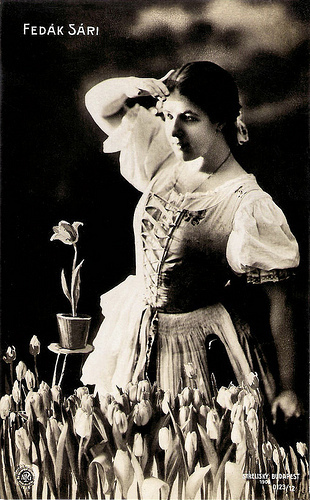
Hungarian postcard by NPG, no. 0123/12,1906. Photo: Strelisky, Budapest.
Angry Crowds Stormed Her House
Sári Fedák or Fédak Sári was born in Beregszász, Hungary (now Berehove, Ukraine) in 1879.
She studied acting with Szidi Rákosi until 1899, and began her career the same year with the Magyar Színház theatre company. From 1900 in, she played in Pozsony (now Bratislava), and in several theatres in Budapest.
In 1907, she was mixed up in a scandal after the suicide of the popular playwright Paul Widor. According to an article in The Los Angeles Herald, angry crowds stormed her house and threatened her with death if she fell into their hands. Fedák was the well paid star in a disastrous stage production of Widor, which had ruined him and caused his suicide.
Sári left Hungary and conquered Berlin in 1908, Vienna in 1909, and London and Paris in 1910. When she returned to Budapest the public welcomed her back.
In 1912, she made her film debut in the short comedy Gazdag ember kabátja/Rich man’s coat (Andor K. Kovács, 1912) based on a story by the famous Hungarian playwright and novelist Ferenc Molnár.
The next year, she co-starred with Alfréd Deésy in Rablélek (1913), directed by Mihály Kertész who later became the famous Hollywood director Michael Curtiz.
In Márta (Ödön Uher ifj., 1913), she co-starred with Várkonyi Mihály, who became internationally known as Victor Varconi .
Another silent film was Három hét/Three Weeks (Márton Garas, 1917), based on a novel by Elinor Glyn.
Following World War I, she spoke out against the Austro-Hungarian monarchy. In 1919, during the short run of the Hungarian Soviet Republic she agitated for joining the Red Army.
After the fall of the Republic, Fedák fled to Vienna, but was captured and held in prison at Wiener Neustadt for a short time.
As a supporter of the Republic, she could play in only Vienna from 1920-21. She made appearances in Berlin and Paris in 1921 and 1925. In 1923, she became a member of the Fővárosi Operettszínház theatre.
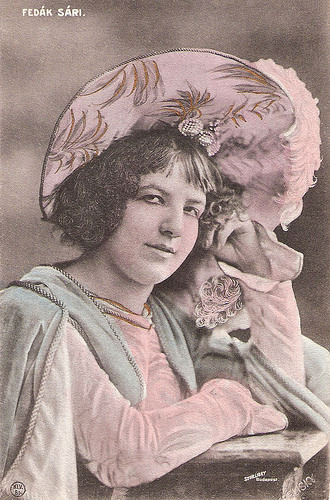
Hungarian postcard by KIV, Budapest. Photo: Strelisky, Budapest.
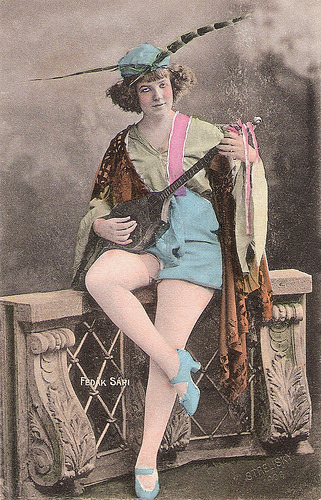
Hungarian postcard by S.J., Budapest. Photo: Strelisky, Budapest.
Intimate Relationships With 42 Gentlemen
In 1922 Sári Fedák married Ferenc Molnár, after a six-year relationship. The couple divorced in 1925 or 1926, after he reportedly had accused her of intimate relationships with 42 gentlemen, and she had replied in kind with a list of 142 ladies who were said to have received his favours.
In 1927 there was another scandal when Fedák was sued by rival actress Vilma Banky . Fedák would have called her ‘that little lowdown Budapest cat’. Time magazine published a report of the trial including a description of Fedák’s entrance in the court room “clad in a black gown tight as a snake skin, looking perhaps half her 43 years”. The court dismissed the case.
After the introduction of sound film, she made her come-back in the cinema with Iza néni/Miss Iza (Székely István a.k.a. Steve Sekely, 1933) opposite Pál Jávor.
In 1934, she toured several American cities. She used her American experiences for the script of Mámi (Vaszari János a.k.a. Johann von Vásáry, 1937) in which she played the title figure, a Hungarian woman retuning from Texas.
The success lead to other films like Az örök titok/The Eternal Secret (István György, 1938), Érik a búzakalász/The Wheat Ripens (Béla Gaál, 1939) and Bob herceg/Prince Bob (László Kalmár, 1941).
Starting in 1940, she was the leading actress in the Új Magyar Színház theatre. In 1944, working at the Donausender radio station in Vienna, she rallied for Hungary to continue the fight in World War II on the side of Nazi Germany. For this act, she was sentenced to eight months in prison after the war, and she was banned from playing in theatres for three years. The court order broke her career: she never appeared on stage again.
After being released from prison, she moved to Nyáregyháza, retiring from active life. Sári Fedák died in 1955 in Budapest, Hungary, aged 75, and was interred in Budapest's Farkasréti Cemetery.
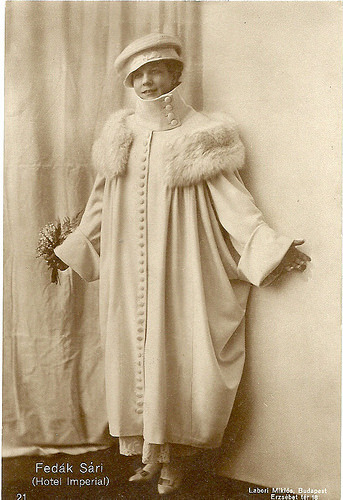
Hungarian postcard, no. 21. Photo: Miklós Labori, Budapest. Collection: Didier Hanson.
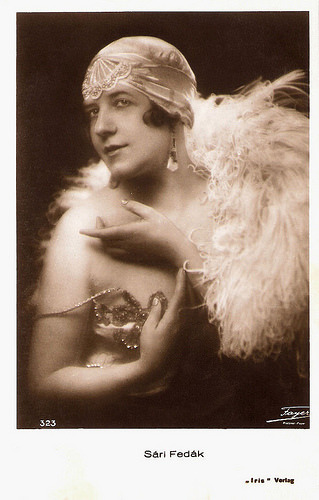
Austrian postcard by Iris Verlag, no. 323. Photo: Fayer.
Sources: Los Angeles Herald, Magyar Színházmüveszeti Lexikon (Hungarian), Wikipedia and .

Hungarian postcard by NPG, no. 0123/12,1906. Photo: Strelisky, Budapest.
Angry Crowds Stormed Her House
Sári Fedák or Fédak Sári was born in Beregszász, Hungary (now Berehove, Ukraine) in 1879.
She studied acting with Szidi Rákosi until 1899, and began her career the same year with the Magyar Színház theatre company. From 1900 in, she played in Pozsony (now Bratislava), and in several theatres in Budapest.
In 1907, she was mixed up in a scandal after the suicide of the popular playwright Paul Widor. According to an article in The Los Angeles Herald, angry crowds stormed her house and threatened her with death if she fell into their hands. Fedák was the well paid star in a disastrous stage production of Widor, which had ruined him and caused his suicide.
Sári left Hungary and conquered Berlin in 1908, Vienna in 1909, and London and Paris in 1910. When she returned to Budapest the public welcomed her back.
In 1912, she made her film debut in the short comedy Gazdag ember kabátja/Rich man’s coat (Andor K. Kovács, 1912) based on a story by the famous Hungarian playwright and novelist Ferenc Molnár.
The next year, she co-starred with Alfréd Deésy in Rablélek (1913), directed by Mihály Kertész who later became the famous Hollywood director Michael Curtiz.
In Márta (Ödön Uher ifj., 1913), she co-starred with Várkonyi Mihály, who became internationally known as Victor Varconi .
Another silent film was Három hét/Three Weeks (Márton Garas, 1917), based on a novel by Elinor Glyn.
Following World War I, she spoke out against the Austro-Hungarian monarchy. In 1919, during the short run of the Hungarian Soviet Republic she agitated for joining the Red Army.
After the fall of the Republic, Fedák fled to Vienna, but was captured and held in prison at Wiener Neustadt for a short time.
As a supporter of the Republic, she could play in only Vienna from 1920-21. She made appearances in Berlin and Paris in 1921 and 1925. In 1923, she became a member of the Fővárosi Operettszínház theatre.

Hungarian postcard by KIV, Budapest. Photo: Strelisky, Budapest.

Hungarian postcard by S.J., Budapest. Photo: Strelisky, Budapest.
Intimate Relationships With 42 Gentlemen
In 1922 Sári Fedák married Ferenc Molnár, after a six-year relationship. The couple divorced in 1925 or 1926, after he reportedly had accused her of intimate relationships with 42 gentlemen, and she had replied in kind with a list of 142 ladies who were said to have received his favours.
In 1927 there was another scandal when Fedák was sued by rival actress Vilma Banky . Fedák would have called her ‘that little lowdown Budapest cat’. Time magazine published a report of the trial including a description of Fedák’s entrance in the court room “clad in a black gown tight as a snake skin, looking perhaps half her 43 years”. The court dismissed the case.
After the introduction of sound film, she made her come-back in the cinema with Iza néni/Miss Iza (Székely István a.k.a. Steve Sekely, 1933) opposite Pál Jávor.
In 1934, she toured several American cities. She used her American experiences for the script of Mámi (Vaszari János a.k.a. Johann von Vásáry, 1937) in which she played the title figure, a Hungarian woman retuning from Texas.
The success lead to other films like Az örök titok/The Eternal Secret (István György, 1938), Érik a búzakalász/The Wheat Ripens (Béla Gaál, 1939) and Bob herceg/Prince Bob (László Kalmár, 1941).
Starting in 1940, she was the leading actress in the Új Magyar Színház theatre. In 1944, working at the Donausender radio station in Vienna, she rallied for Hungary to continue the fight in World War II on the side of Nazi Germany. For this act, she was sentenced to eight months in prison after the war, and she was banned from playing in theatres for three years. The court order broke her career: she never appeared on stage again.
After being released from prison, she moved to Nyáregyháza, retiring from active life. Sári Fedák died in 1955 in Budapest, Hungary, aged 75, and was interred in Budapest's Farkasréti Cemetery.

Hungarian postcard, no. 21. Photo: Miklós Labori, Budapest. Collection: Didier Hanson.

Austrian postcard by Iris Verlag, no. 323. Photo: Fayer.
Sources: Los Angeles Herald, Magyar Színházmüveszeti Lexikon (Hungarian), Wikipedia and .
Published on June 05, 2014 23:00
Paul van Yperen's Blog
- Paul van Yperen's profile
- 13 followers
Paul van Yperen isn't a Goodreads Author
(yet),
but they
do have a blog,
so here are some recent posts imported from
their feed.



